NBER WORKING PAPER SERIES
COMMUNICATION AND BARGAINING BREAKDOWN:
AN EMPIRICAL ANALYSIS
Matthew Backus
Thomas Blake
Jett Pettus
Steven Tadelis
Working Paper 27984
http://www.nber.org/papers/w27984
NATIONAL BUREAU OF ECONOMIC RESEARCH
1050 Massachusetts Avenue
Cambridge, MA 02138
October 2020
We are grateful to numerous seminar and conference participants, as well as to Charles
Angelucci, Anne Bartel, Wouter Dessein, Liran Einav, Sarah Moshary, Michaela Pagel, Andrea
Prat, and especially Jonah Rockoff for thoughtful comments, as well as many eBay employees for
their input and support, and finally Brenden Eum and Alphonse Simon for excellent research
assistance; all remaining errors are our own. Part of this research was supported by NSF Grant
SES-1629060. Matt Backus has in the past been a paid consulting researcher for eBay Inc. The
views expressed herein are those of the authors and do not necessarily reflect the views of their
employers, eBay, or the National Bureau of Economic Research.
NBER working papers are circulated for discussion and comment purposes. They have not been
peer-reviewed or been subject to the review by the NBER Board of Directors that accompanies
official NBER publications.
© 2020 by Matthew Backus, Thomas Blake, Jett Pettus, and Steven Tadelis. All rights reserved.
Short sections of text, not to exceed two paragraphs, may be quoted without explicit permission
provided that full credit, including © notice, is given to the source.

Communication and Bargaining Breakdown: An Empirical Analysis
Matthew Backus, Thomas Blake, Jett Pettus, and Steven Tadelis
NBER Working Paper No. 27984
October 2020
JEL No. C78,D82,D83,M21
ABSTRACT
Bargaining breakdown—whether as delay, conflict, or missing trade—plagues bargaining in
environments with incomplete information. Can a bargaining environment that facilitates or
restricts communication alleviate these costs? We exploit a unique opportunity to study this
question using real market transactions: eBay Germany’s Best Offer platform. On May 23, 2016,
the platform introduced unstructured communication allowing buyers and sellers on the desktop
version of the site, but not the mobile app, to accompany price offers with a message. Using this
natural experiment, our difference-in-differences approach documents a 14% decrease in the the
rate of breakdown among compliers. Though adoption is immediate, the effect is not. We show,
using text analysis, that the dynamics are consistent with repeat players learning how to use
communication in bargaining, and that the messaging strategies of experienced sellers are
correlated with successful bargaining.
Matthew Backus
Graduate School of Business
Columbia University
3022 Broadway, Uris Hall 619
New York, NY 10027
and NBER
Thomas Blake
eBay Research Labs
2065 Hamilton Ave
San Jose, CA 94125
Jett Pettus
Columbia University
Steven Tadelis
Haas School of Business
University of California, Berkeley
545 Student Services Building
Berkeley, CA 94720
and NBER
1 Introduction
Bargaining is the mechanism of choice for many of our most important transactions:
peace negotiations, federal budgets and the formation of governing coalitions, allocation
of refugees, the sale of a business, the purchase of a car, child care duties, and the
number of bedtime stories, to name a few. Yet at least since Myerson and Satterthwaite
(1983), economists have understood the potential for failure in bargaining. When
parties to a negotiation do not know each other’s reservation values, each has an
incentive to overstate the strength of their position to get a better deal, sometimes
resulting in costly delays, and other times in a complete loss of socially beneficial trades.
In this spirit, Crawford (1982) posits that “the potential welfare gains from improving
the efficiency of bargaining outcomes are enormous, perhaps even greater than those
that would result from a better understanding of the effects of macroeconomic policy.”
We consider an open question in this domain: does communication improve the
efficiency of bargaining outcomes, or is it all “cheap talk?” Charness (2012) writes:
For many, the word bargaining conjures an image of people sitting around
a table talking. Yet communication is one of the least understood facets
of bargaining. Most economic models of bargaining assign no role for
communication beyond conveying offers or their acceptability. But clearly,
communication does a lot more than that.
He continues, presciently, “this area should be of great importance in the coming
years, particularly given the strong trend to virtual interaction in bargaining.” Here,
we offer evidence on this question using data from such a virtual bargaining platform:
eBay’s Best Offer bargaining marketplace. We present two main findings: first, we
document a statistically and economically significant positive relationship between the
availability of free-form text communication and bargaining success. Second, applying
text analysis techniques to users’ messages, we document a convergent pattern which,
we argue, represents repeat players learning how to communicate in the bargaining
protocol. We show that this pattern is related to experience, and that the strategies
adopted by experienced bargainers are correlated with successful negotiation. This is
consistent with prior findings in experimental work demonstrating that beyond the
ability to communicate, the content of communication matters as well for bargaining
outcomes. Our work is, to the best of our knowledge, the first study of the role of
communication in bargaining using data from real-world bargaining interactions.
1

Our findings relate to a broader debate concerning the restriction of communication
in bargaining which, in practice, is quite common. A high stakes example from
international relations is “shuttle diplomacy,” which played a high-profile role in many
negotiation episodes in the twentieth century. Theoretical models of such mediation,
itself a medium of communication, focus on the informational role of these restrictions,
as against the theoretical limitations of baseline of unverifiable cheap talk (Fey and
Ramsay, 2010; H¨orner et al., 2015). Yet these theoretical limitations offer limited
perspective on real-world bargaining, which is rife with cheap talk (very little of which,
in our setting, resembles meaningful exchange of information).
This is particularly salient for marketplaces, where bargaining is increasingly
commonplace. eBay’s Best Offer bargaining platform, which allows sellers to receive
and respond to offers from potential buyers, accounts for approximately 10% of eBay’s
trade volume, which was
$
84 billion globally in 2016.
1
On the Chinese platform
TaoBao, which hosted trade volumes of
$
115 billion in 2016, bargaining is the standard
for all transactions.
2
And in, in 2014, Amazon.com introduced their own bargaining
mechanism for the Amazon Marketplaces platform called “Make an Offer.” All of
these platforms face the question of how and whether to regulate communication.
Our setting is the Best Offer bargaining platform on eBay.de, the German counter-
part of eBay.com.
3
Sellers who create a listing on the website may enable Best Offer,
a free feature that allows buyers to make offers below the listing price. An offer may
be countered, and the counter-offer countered, etc., yielding a protocol very similar
to sequential, alternating-offers bargaining (Rubinstein, 1982). Originally, eBay.de
did not allow communication, and only numerical offers were relayed between the
parties.
4
However, in a policy change that took effect May 23, 2016, offers could
be accompanied by a 250-character message when made from the eBay.de website.
Importantly, the change did not affect buyers who made offers using their mobile
devices. The sudden nature of the change and its incomplete coverage affords us a
natural experiment to study the role of communication in bargaining.
1
See Backus et al. (2020) and eBay’s 2016 10k SEC filing.
2
On TaoBao, communication is encouraged between buyers and sellers on an instant messenger
service. This has been cited as a factor in their success over the Chinese equivalent of eBay
(Oberholzer-Gee and Wulf, 2009).
3
This platform is also used in Gizatulina and Gorelkina (2017), who conduct a field experiment
selling gift cards on the platform to study surplus division.
4
We believe this has to do with the origins of eBay.de, which was originally developed by Rocket
Internet SE in 1999 and then sold to eBay.com. Thanks to Ariel Stern for pointing this out.
2
We find that, while the typical bargaining session in our sample was successful forty-
four percent of the time, bargainers who used messages were eight percentage points
more likely to transact than they would have been in the absence of communication.
This corresponds to a fourteen percent reduction in the rate of bargaining breakdown.
We do not observe bargainers’ private values, so “breakdown” is not the same as
inefficiency (e.g., if a seller values the product more than the buyer, then breakdown
is an efficient outcome). Therefore our computation is conservative in the sense that
the denominator is too large—the decrease in the rate of inefficient breakdown is
likely to be much larger. Additionally, examining week-specific effects, we find that
the effect of communication grows gradually over the four weeks after introduction.
One mechanism that may drive this pattern is that it takes time for players to learn
how to best make use of the new feature after the change.
To explore this mechanism, we implement a descriptive analysis of the content of
the communications. Most notably, we offer evidence that over the weeks following
the introduction of communication, sellers’ communication strategies evolve as they
learn to use the communication feature in bargaining. In contrast, the content of
buyers’ communications is largely random, which is consistent with our intuition, and
their behavior on eBay, that they are occasional, short-run players. We show that not
only are repeat sellers’ strategies changing over time, but that they are convergent,
supporting the hypothesis that they are learning. Consistent with this, we show that
messages most similar to the endpoint of that convergence are more likely to succeed,
with a magnitude that is remarkably close to our estimates of the treatment effect on
the treated from the introduction of messaging. We also, in an Appendix, borrow tools
from text analysis to learn about what sellers are converging to; though this analysis is
entirely descriptive, the findings are consistent with behavioral and experimental work
which shows that cost-based rationales are effective, and overly effusive communication
strategies can be counterproductive.
Turning to prior work, our paper is the first, to the best of our knowledge, to study
the role of communication on bargaining using real-world bargaining interactions.
There is, however, substantial prior theoretical and experimental work. Surveying
theoretical contributions, Crawford (1990) distinguishes between tacit and explicit
models of bargaining, where tacit models leave no role for communication. All of
noncooperative bargaining theory is tacit; it abstracts away from talk to focus on
actions: offers, counteroffers, delay, agreement, and exit. For practitioners, however,
3

haggling and negotiation are understood as communication, which may explain the
minor role of economic theory in negotiation coursework among students of law and
business. More recent work studies explicit bargaining, in which communication
is modeled as cheap talk.
5
There is significant disagreement on the efficiency of
allowing cheap talk: theoretical work predicts that, among rational actors, it is at
best irrelevant, and possibly detrimental to bargaining efficiency.
6
In the latter case
restricting communication is a form of pre-commitment, which may improve outcomes.
In contrast, experimental work has found potential for communication to improve
outcomes in bargaining among other games.
7
Indeed, bargaining experiments that
manipulate the availability of communication (Radner and Schotter, 1989; Valley et
al., 2002) offer evidence that communication may permit bargaining efficiency that
exceeds the theoretical upper bounds outlined by Myerson and Satterthwaite (1983).
However, these results have not been validated in the field, and subsequent extensions
are not uniformly positive: Ert et al. (2014) construct an experimental scenario with
misalignment of incentives, similar to bargaining over lemons, where communication
elicits skepticism and increases breakdown; Bolton et al. (2003) and McGinn et al.
(2012) highlight drawbacks of communication in bargaining games with more than
two players, and Lee and Ames (2017) and Jeong et al. (2019) show how the content
of the messages can facilitate or inhibit negotiations.
Communication is of interest for antitrust economics, where colluding parties have
to bargain over the division of surplus. Cooper and K¨uhn (2014) experimentally study
the role of communication in repeated Prisoners’ Dilemma games; Awaya and Krishna
(2015) show how cheap-talk communication can overcome the problem of secret price
cuts in collusive arrangements, and Harrington and Ye (2019) show how cheap-talk
5
This literature typically appends a cheap-talk “pre-game” to an existing bargaining model. See,
e.g., Farrell and Gibbons (1989), Cabral and S´akovics (1995), for early examples, and Menzio (2007)
for a formalization of partially directed search in models of cheap-talk wage-posting.
6
See Goltsman et al. (2009) for a treatment and review of communication and bargaining in the
cheap-talk setting described by Crawford and Sobel (1982), and, in the legal literature, Brown and
Ayres (1994) and Ayres and Nalebuff (1997).
7
In experiments mirroring Crawford and Sobel (1982), Cai and Wang (2006) find that subjects
consistently reveal “too much” information to be rationalized by equilibrium behavior. This is
consistent with lie aversion (Gneezy, 2005; Gibson et al., 2013) and guilt aversion (Charness and
Dufwenberg, 2006, 2011), as well as communication fostering other-regarding preferences (Coffman
and Niehaus, 2020). Crawford et al. (2013) argue that it is consistent with level-K thinking, even in
the absence of preferences for truthfulness, as L0 types anchor on the truth. In games with multiple
equilibria, communication helps coordination on better outcomes (Cooper et al., 1992; Blume and
Ortmann, 2007; Ellingsen and
¨
Ostling, 2010). McGinn et al. (2003) offer evidence for this mechanism
by showing that communication elicits dyadic strategies by bargainers.
4

communication among sellers in an upstream market can facilitate collusion when
the downstream market is characterized by negotiations, as in many intermediate
goods markets. Clark and Houde (2014) offer an empirical example of the role of
communication in collusion, studying the collapse of a cartel resulting from antitrust
enforcement equipped with a wire tap in Quebec. Moreover, in a setting that features
on-path bargaining breakdown but not communication, Loertscher and Marx (2020)
show how mechanism design can be used to understand bargaining and countervailing
power in antitrust.
Finally, our work contributes to the literature on learning in strategic settings.
Empirical work in this area is particularly scarce because there are few opportunities to
observe the introduction of a novel mechanism in a continuously operating marketplace.
In this respect, our work is related to Doraszelski et al. (2017), who document bidding
behavior in a newly opened electricity auction market. Our exercise builds on the
recent introduction of text analysis and natural language processing; see Gentzkow
et al. (2019a) for a survey. For the same reason that we need new tools to study
text—that messages live in a high-dimensional space—we conjecture that it is a natural
environment to study learning and experience.
8
Section 2 describes the eBay.de platform, and Section 3 describes the dataset and
explain the motivation for the sample design. Section 4 offers a discussion of identifi-
cation and our main causal estimates of the effect of communication on bargaining
breakdown. Section 5 presents a descriptive analysis of the text communication itself
in order to match the patterns we find, and Section 6 shows that our text analysis
findings are consistent with message-level regressions predicting successful bargaining.
Finally, Section 7 concludes with a brief discussion of the implications for platforms
and future directions for empirical work on communication and bargaining.
8
Though no prior work isolates the interaction of communication and experience in bargaining,
there is evidence of the importance of experience in bargaining: see, e.g. Card and Dahl (2012), who
documented the role of expertise in bargaining agents in arbitration, and Backus et al. (2020), who
found effects of experience on bargaining outcomes on eBay.com.
5

Figure 1: Example of a Best Offer Listing
Notes: This is an example View Item page for a Best-Offer enabled listing. A buyer may purchase at the asking price
of $55 by clicking the Buy-It-Now button, or they may engage in bargaining by clicking the Make Offer button.
2 Our Empirical Setting: Bargaining on eBay.de
2.1 Best Offer Bargaining
eBay’s online platform matches buyers to sellers who sell products ranging from art
and collectibles to mobile phones, with over
$
95 billion dollars in gross merchandise
volume worldwide in 2018. The platform operates in many markets throughout the
world, the largest by revenue are the US (eBay.com) and Germany (eBay.de).
9
Sellers who list an item choose either an auction or fixed-price (“Buy-it-Now”)
format. We focus on a subset of fixed-price listings for which the seller enables the
“Best Offer” bargaining feature as shown in Figure 1. A buyer considering this listing
has two options to purchase the good: they can either purchase at the posted asking
price (here,
$
55), or they can offer to purchase at a lower price. If the buyer makes an
offer, the seller is notified and they may then accept, decline, or make a counter-offer. If
the seller makes a counter-offer, the buyer may accept, decline, or make a counter-offer,
and so on, in the spirit of Rubenstein-St¨ahl alternating, sequential-offers bargaining.
Offers by either party expire automatically after 48 hours.
10
9
Figure and revenue ranking based on eBay’s 2018 Annual Report.
10
For a more thorough descriptive characterization of the Best Offer environment, see Backus et al.
(2020). Data from that study, which are collected from the US site eBay.com, are publicly available
at http://www.nber.org/data/bargaining/.
6
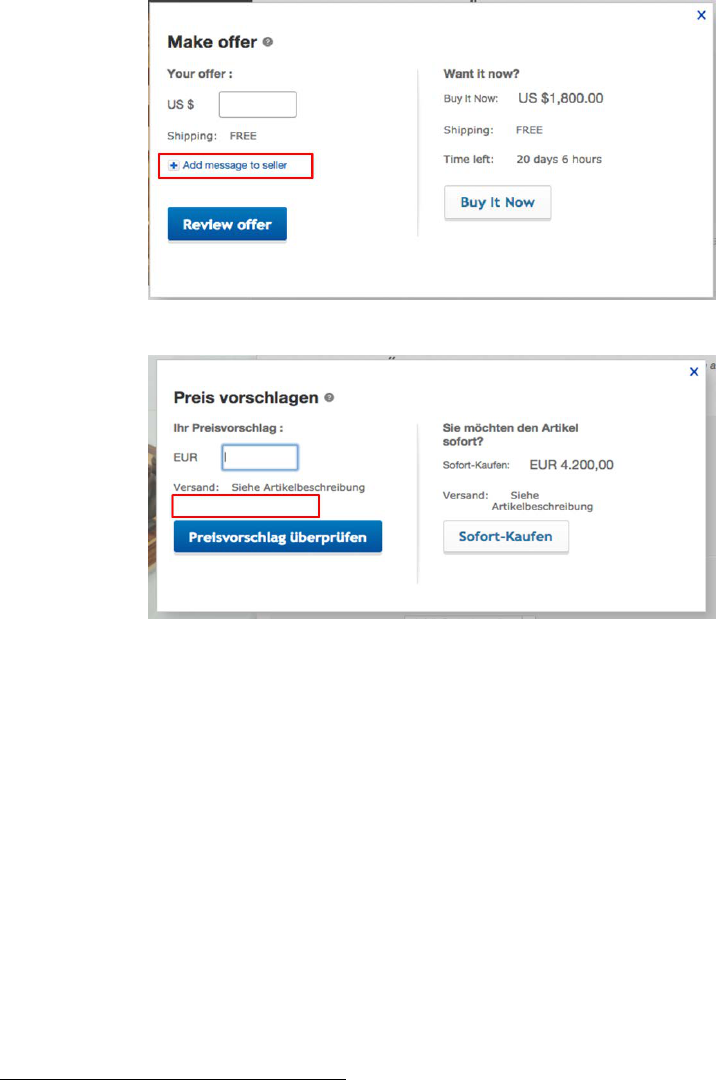
Figure 2: Messages and Best Offer
(a) eBay.com
(b) eBay.de (before May 23, 2016)
Notes: Panel (a) depicts the “Make Offer” panel for eBay.com, the US site, where we have highlighted the “add
message to seller” button. Panel (b) depicts the pre-treatment panel on eBay.de, where there is no option to send a
message.
The Best Offer bargaining mechanisms on eBay.com and eBay.de are mostly
identical except for one peculiarity that was unique to eBay.de up until the policy
change we study: bargainers weren’t allowed to communicate like on eBay.com. Figure
2(a) depicts the “Make Offer” interface through which buyers submit their offer, for
eBay.com. If a buyer clicks the “add message to seller” button, they may include
a free-form text message of up to 250 characters which will accompany their offer.
Figure 2(b) depicts the parallel “Preis Vorschlagen” interface, for eBay.de. The red
rectangle highlights where the missing option to send a message might have been.
11
11
The reason for the difference is unclear, but it may be a historical artifact: eBay.de is the
successor of Alando.de, a clone of eBay.com created by the company Rocket Internet in 1999. 100
days after its creation, it was sold to eBay for
$
43 million. Thanks to Ariel Stern of HBS for pointing
this out.
7
2.2 The Policy Change: May 23, 2016
On May 23, 2016, the “add a message to seller” feature was added to eBay.de’s Best
Offer bargaining platform. However, the rollout on that date was partial. The website
eBay.de was updated, but the app for mobile users was not.
The policy change affords the main source of variation that we will exploit in this
paper. Unlike many changes to the eBay platform, the introduction of messaging
on eBay.de was not accompanied by a far-reaching “seller update”, and no other
major changes to the eBay.de experience happened around this change. Moreover,
the availability of an untreated group in the post period (mobile users) affords us a
control group in order to separate changes in behavior from a secular trend.
3 Dataset and Sample Design
We obtained proprietary data from eBay itself to evaluate the effect of messaging
on bargaining breakdown. We study bargaining interactions, which we define as a
buyer-item pair in which we observe at least one offer. Our main dataset includes all
interactions for which the first buyer offer was made during an eight-week window
between April 26, 2016 and June 20, 2016, constructed to be four weeks before and
four weeks after the introduction of messaging on May 23, 2016.
3.1 Summary Statistics
Table 1 presents summary statistics for the main sample across several dimensions:
listings, buyers, sellers, and interactions. This sample includes 3.3 million interactions
involving 2.2 million unique listings, 444 thousand sellers, and 1.6 million buyers. The
listings span all categories of eBay excluding real estate, automobiles, and tickets. As
documented by Backus et al. (2020), Best Offer is more frequently used in categories
with substantial heterogeneity, such as Collectibles. Listings observed in our sample
have on average 1.5 interactions (note that our sample excludes listings with zero
interactions) and the distribution is highly skew: 79 percent have only one; 91 percent
8

have two or fewer, 96 percent have three or fewer, and there is a right tail with many
more.
12
55 percent ultimately sell through the Best Offer mechanism.
13
Both buyers and sellers may be involved in multiple interactions—on average, 2.1
and 7.4, respectively. In both cases there is substantial positive skew, suggesting a
large right-tail of highly-active participants. On the buyer side, this derives from the
fact that most (60%) are only observed in a single interaction, while the top decile
participates in four or more interactions. On the seller side, only 34% of the sample is
observed only once, while the top decile participates in twelve or more interactions.
This difference motivates our interpretation of buyers as short-run players and sellers
as long-run players. These patterns hold for sales and purchases as well.
At the interaction level, which is the unit of observation for the empirical analysis
that follows, we see that 44% of interactions end in a sale. These facts are consistent
with findings in prior work using data from the U.S. site eBay.com (Backus et al.,
2019, 2020). The final two interaction-level variables of Table 1 are of unique interest
to this paper: interactions may be initiated by buyers using the desktop version of
eBay (54%) or the mobile version (46%), which is important because only desktop
buyers have the opportunity to send messages after the policy change. Finally, 50% of
our sample falls after the policy change on May 23, 2016.
3.2 Additional Controls
In addition to the basic characteristics summarized in Table 1, we have a number of
controls available to predict bargaining breakdown. These include the asking price of
the seller; dummy variables by product category and condition (new, used, refurbished,
or unknown); and dummy variables for the day of the week on which the first offer in
an interaction is made (to allow for differential behavior on weekends and weekdays);
a “holiday” dummy, which encodes all publicly observed holidays in Germany, as
there is a particularly large number of them in May.
14
We also include controls for the
weather in Frankfurt, Hesse, which we expect to be correlated with weather elsewhere
12
Partly for this reason, and partly because Best Offer listings tend to take longer to sell than, say,
auctions, we ignore the possibility of competing offers by buyers. This is intuitive, since sellers also
have the option to hold an auction on the eBay platform.
13
Listings that sold at the Buy-it-Now price are not classified as an interaction because no
negotiation is involved. These sales do not appear in our dataset.
14
Publicly observed holidays in our sample include: May 1, Labor day; May 5, Ascension Day;
May 8, Mother’s Day; May 16, Whit Monday, and May 26, Corpus Christi.
9

Table 1: Summary Statistics
Mean Std. Dev. Skewness Min Max
Listing-Level Data
Asking Price (USD) 100.6 151.5 2.889 1.050 999.9
Number of Interactions 1.490 2.566 82.62 1 1004
1(Sold) 0.563
N 2210575
Seller-Level Data
Number of Interactions 7.426 42.30 47.81 1 7142
Number of Sales 3.279 20.76 44.17 0 3115
N 443644
Buyer-Level Data
Number of Interactions 2.101 3.102 20.24 1 396
Number of Purchases 0.928 1.526 25.26 0 389
N 1567995
Interaction-Level Data
Number of Offers 1.873 1.116 1.535 1 6
1(Ended in Sale) 0.442
1(Buyer on Desktop) 0.537
1(First offer after May 23) 0.501
N 3294362
Notes: This table presents summary statistics for the main dataset of Best Offer interactions taking place within an
eight-week window, four weeks before and four weeks after the policy change on May 23, 2016. Fixing that set of
interactions, we have constructed the summary statistics four ways: where the unit of observation is the listing (i.e.,
the product), the buyer, the seller, or the interaction itself.
in Germany, as weather conditions are both serially correlated and anecdotally cited
as affecting online activity. These include a dummy for precipitation as well as the
deviation of temperature from a linear trend over the sample.
3.3 Adoption on May 23, 2016
As depicted in Figure 3(a), users adopted messages rapidly: within days, the hazard
rate with which bargaining interactions by desktop-only buyers involved messaging
stabilized at approximately six percent. Both panels in Figure 3 distinguish between
the case where the buyer is either exclusively making offers from a desktop computer
or exclusively making offers from a mobile device. We do this because there was
initially no messaging feature for the eBay.de mobile app. Therefore in Panel (a),
which plots the hazard rate at which interactions involve any message (both seller and
buyer messages), the hazard rate for the case where the buyer is on the mobile app is
much lower. These are exclusively messages sent by sellers, to mobile-only buyers who
10
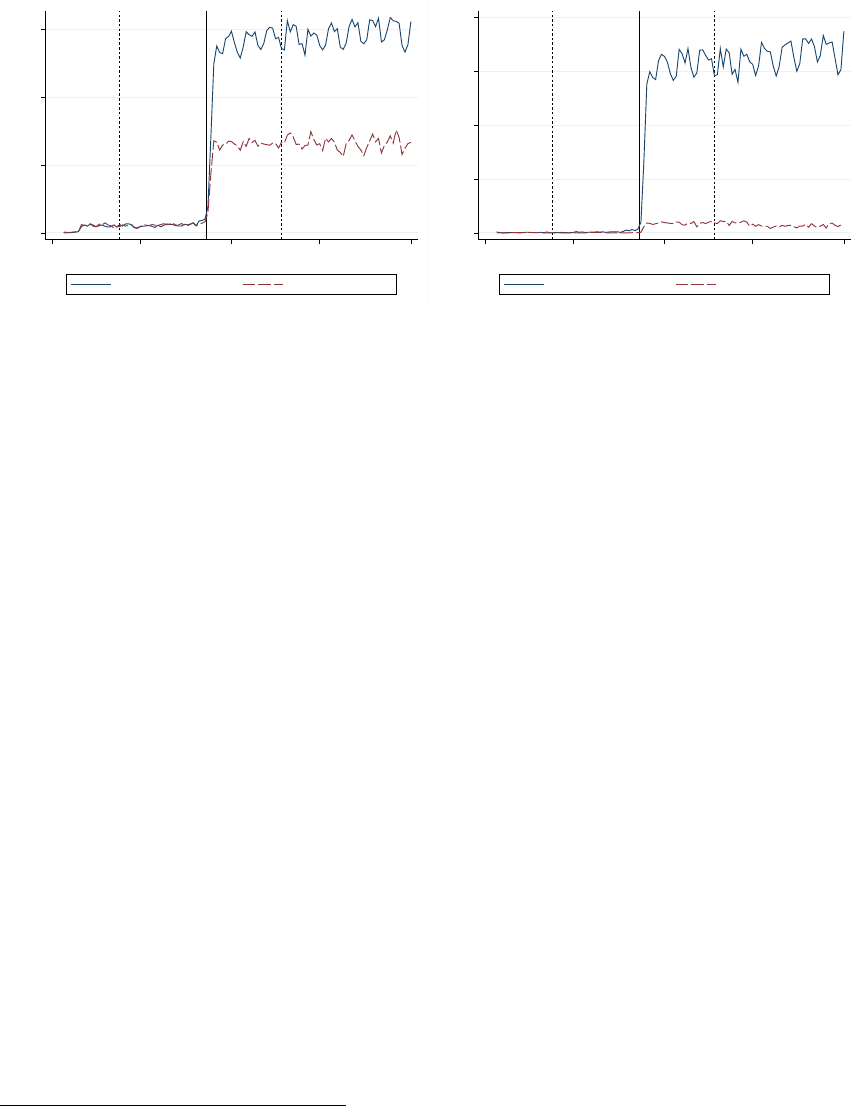
Figure 3: Launch of Messaging Feature
0 .02 .04 .06
Fraction with Any Message
01apr2016 01may2016 01jun2016 01jul2016 01aug2016
Time
Buyer is Desktop Only Buyer is Mobile Only
(a) Any Message
0 .01 .02 .03 .04
Fraction with Buyer Message
01apr2016 01may2016 01jun2016 01jul2016 01aug2016
Time
Buyer is Desktop Only Buyer is Mobile Only
(b) Buyer Message
Notes: Panel (a) depicts the fraction of interactions, by first offer date, in which a message was included by the seller.
Panel (b) restricts attention to cases where the message was sent by a buyer. Both panels split the sample by whether
the buyer was active on the desktop or mobile version of the platform. The solid vertical line represents the policy
change. Dashed vertical lines depict the bounds of the eight-week window, centered at launch, of our main sample.
cannot read them. In Panel (b), we plot the hazard rate of buyer messages, which
confirms that mobile-only buyers are not sending messages after the change.
15
4 The Effect of Introducing Communication on
the Likelihood of Bargaining Breakdown
4.1 Empirical Design and Identification
4.1.1 OLS and Endogeneity
Our identification strategy is meant to circumvent the most salient problem, that the
choice to include a message is endogenous. In particular, we expect a negative bias:
that bargainers send messages for goods of a type where bargaining is least likely to
succeed, or in order to motivate a particularly aggressive offer.
We illustrate this by estimating a linear probability model, the details of which
can be found in Appendix Section A. The unconditional correlation between the
15
About 0.1% of offers per day included messages prior to the feature launch, and similarly there
are cases where mobile-only buyers appear to send messages. In the former case, these are seller-side
only, and rarely in German, so we believe that they are anomalies related to sellers registered on
multiple sites. In the latter, we believe that these are simple database errors.
11
presence of a message and bargaining success is negative, but once we condition
on the log of the asking price it is small and positive. This reflects the fact that
bargaining interactions with messages tend to involve goods that are more expensive
than bargaining interactions that do not, and that bargaining success is less likely for
more expensive products, as documented by Backus et al. (2020) for eBay.com.
We expect this problem to be at least as important for unobservable characteristics
than the asking price, and therefore rely on the policy change for a natural experiment
and a more credible estimate of the effect of communication on bargaining breakdown.
4.1.2 Identification
The variation generated by the May 23, 2016 policy change allows us to identify the
effect of communication in two ways. The first is a simple pre-post design studying
the change in the mean success rate of bargaining interactions before and after the
policy change among desktop users. Our dependent variable is
1
(success), a dummy
for whether the bargaining interaction ends in a sale. Let
X
denote a set of controls,
P
(alternatively, “post”) a dummy equal to one if the first offer in an interaction is in
the post period, and
D
(alternatively, “desktop”) a dummy equal to one if the buyer
makes offers from the desktop version of eBay.de. Then, the pre-post estimate of the
effect of communication on bargaining success is given by:
ˆ
β
C
pp
= E[1(success)|X, P = 1, D = 1] − E[1(success)|X, P = 0, D = 1]. (1)
We can then use the untreated set of buyers who made offers on the mobile
platform—where messaging was unavailable both before and after May 23, 2016—to
control for common trends and alleviate concerns of endogeneity. This suggests a
differences-in-differences design:
ˆ
β
C
dd
=(E[1(success)|X, P = 1, D = 1] − E[1(success)|X, P = 0, D = 1]) (2)
− (E[1(success)|X, P = 1, D = 0] − E[1(success)|X, P = 0, D = 0]).
Both of the above strategies identify an effect that should be interpreted as an
intent to treat (ITT) estimate, i.e., an estimate of the effect of the availability of
communication, rather than the effect of actually choosing to communicate. In order
12

Table 2: Complier Characteristics
P(x=1) P(x = 1 | complier)
P(x=1|complier)
P(x=1)
Ask Price in ($0,$50) 0.52 0.41 0.78
Ask Price in [$50,$150) 0.27 0.29 1.08
Ask Price in [$150,$250) 0.09 0.11 1.30
Ask Price ≥ $250 0.12 0.19 1.54
Friday, Saturday, or Sunday 0.42 0.42 1.00
Precipitation 0.46 0.67 1.46
Holiday 0.10 0.03 0.32
Post 0.50 1.00 2.00
Desktop 0.54 1.00 1.86
Notes: This table summarizes complier characteristics, i.e. the characteristics of interactions in the treatment group
that “comply” and involve a message between bargainers. Each row represents a dummy variable which is taken to
be x in the column formulas above.
to identify the treatment effect on the treated (TOT), we need to clarify who the
compliers, i.e., those we actually consider to be treated, are.
4.1.3 ITT and TOT: Who are Compliers?
We say that a bargaining interaction is in the ITT group if the first offer occurs after
May 23, 2016 and if the buyer uses the desktop version of eBay.de. Not every such
interaction involves a message. By definition, compliers are interactions in our ITT
group in which a message is sent by either party. Some messages were sent outside of
this group, e.g., when a seller sends a message to a buyer who is using the mobile app.
We exclude these for two reasons: first, because the buyer was mechanically unable
to read the message, and second, because it turns out that using this less-restrictive
definition will cause us to overstate the magnitude of the TOT estimate.
16
Table 2 summarizes the characteristics of the compliers. Of particular note is the
fact that bargainers are more likely to send messages when the asking price is higher,
consistent with the intuition that communication is costly. The higher likelihood of
precipitation and lower likelihood of a holiday is due mostly to early-May holidays and
late-May rains, and we note that weekend users are no more likely to send messages.
17
16
Results are available on demand from the authors, however the intuition is simple: including
messages in the pre-period or mobile set but not in the intent-to-treat group will inflate the coefficients
on
1
(Post) and
1
(Desktop), respectively, and thereby depress the coefficient on
1
(Post)
·1
(Desktop).
Since the first-stage coefficient (which is in the denominator) is smaller, the IV effect will be inflated.
Including all non-ITT messages will approximately double the estimate.
17
We group Friday, Saturday, and Sunday based on the OLS coefficients reported in Table A-1,
where weekends appear to be discretely different from weekdays.
13
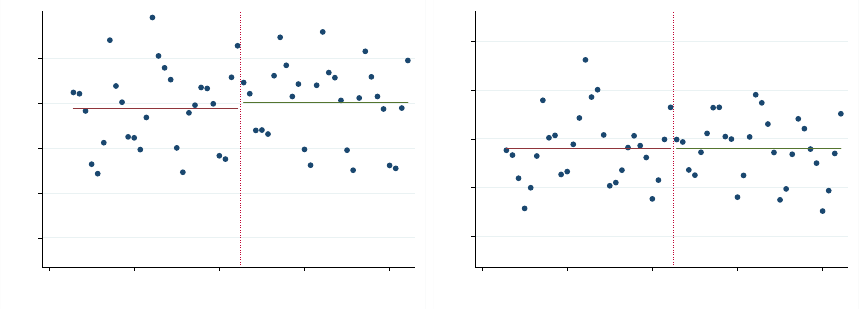
Figure 4: Predicted Success Rates
.44 .45 .46 .47 .48
Predicted Probability
22apr2016 06may2016 20may2016 03jun2016 17jun2016
Day
(a) Desktop
.39 .4 .41 .42 .43
Predicted Probability
22apr2016 06may2016 20may2016 03jun2016 17jun2016
Day
(b) Mobile
Notes: Panel (a) depicts predicted success rates using a large set of controls (ln(ask price); category by condition
fixed effects; day of week, precipitation, and holiday dummies and the temperature) for desktop users only. Panel (b)
replicates this for the mobile users. The vertical axes on both plots are scaled identically subject to a location shift.
It is natural to wonder whether despite our controls, unobservable characteristics
of the listings are generating compositional differences in the periods before and after
the change. Therefore, in Figure 4 we document the predicted success rate conditional
on those controls for all interactions for both samples—mobile and desktop—where
the first-stage regression excludes the dummy for treatment as well as the time trend.
We see a small change in the predicted likelihood of success for desktop users and none
for mobile users, so we anticipate slightly smaller effects when we include controls.
4.2 Empirical Results
4.2.1 Regression Analysis
In what follows, we first generate precise estimates
ˆ
β
C
pp
and
ˆ
β
C
dd
, and second, we identify
a treatment effect on the treated because, recall from Figure 3, only a small fraction
of interactions in the post period involve a message. To accomplish the former, we
reformulate (1) and (2) in terms of a linear probability model and estimate them using
OLS (in all of what follows we omit observation indices):
1(success) = β
0
pp
+ Xβ
1
pp
+ P β
C
pp
+ ε, (3)
and
1(success) = β
0
dd
+ Xβ
1
dd
+ P β
2
dd
+ Dβ
3
dd
+ P Dβ
C
dd
+ ε. (4)
14
Next we consider the treatment effect on the treated. We estimate this by reformulating
(4) as an instrumental variables regression:
1(success) = β
0
iv
+ Xβ
1
iv
+ P β
2
iv
+ Dβ
3
iv
+ 1(complier)β
C
iv
+ ε, (5)
where
P · D
is an instrument for
1
(complier), and
1
(complier) is a dummy for
interactions in the ITT group that include a message. Importantly, this does not
employ any variation that is not already used in the differences-in-differences estimator.
Instead, it just rescales the estimate to the end of interpreting its economic meaning.
As with all estimates of the treatment effect on the treated, it should be interpreted
with caution, as bargainers’ decision of whether to send a message is endogenous.
Results for each of these three estimators, both with and without the controls
discussed in Section 2, are presented in Table 3. We see a large effect of the policy
change on success for desktop users, 0.46 percentage points in model (1), which is
attenuated by the inclusion of controls to a statistically insignificant effect of 0.23
percentage points in model (2). As we show in the next section, the control that
attenuates the result is the time trend. In the post period, there is a substantial
positive drift, which stabilizes after a few weeks. Is this a delayed treatment effect, or
a secular trend on the platform? To distinguish between these hypotheses, we need a
suitable control group; here, interactions involving buyers who use the mobile app.
Critically, as we see in models (3) and (4), our estimates of
β
C
pp
for the placebo
sample of mobile users are very close to zero. Therefore, differences in differences
estimates in models (5) and (6), where the relevant estimate is the term on the
interaction effect, are of the same order as those in (1): we estimate effects of 0.40
and 0.42, respectively. In particular for specification (6), with the rich set of controls,
the mobile group is distinguishing common time trend from the ITT estimate.
Finally, models (7) and (8) report the IV estimates which are rescaled to obtain the
TOT estimate. As only a small fraction of users, approximately six percent, actually
send messages in the post period, this means that the roughly half-percent effect on
conversion for the Best Offer environment at large translates to a substantially larger
and economically important effect on the treated. To be precise, versus a baseline
probability of success near 44% for the full sample (from Table 1), interactions that
involve messages in the treated group are 7.44 (or 7.73, with controls) percentage
points more likely to succeed. The inclusion of these controls (time trend; ln(ask price);
category by condition fixed effects; day of week, precipitation, and holiday dummies
15

and the temperature) allows us to rule out the most salient alternative hypotheses
by which the effect is driven by compositional changes spurred by the introduction
of communication, e.g. if messaging prompts buyers to bargain over cheaper goods
which also have lower rates of breakdown. This leaves is with our main result: a 14%
decrease in the rate of bargaining breakdown among the compliers.
Finally, a note on size and power: we are looking at extremely small effects, on
the order of half a percentage point. They are small because take-up of the messaging
feature among the ITT group, i.e., the compliance rate, is low, at approximately six
percent. While we have a lot of data in our main sample—3.41 million bargaining
interactions—this turns out to be close to what we need. Simple power calculations for
the detection of an effect of 0
.
005 with a baseline success rate of 0
.
442 (borrowed from
Table 1) with a confidence of
α
= 0
.
05 and a power of fifty percent implies that we
need a dataset of 2.72 million experimentally generated observations equally divided
between treated and not. Therefore there are limitations on how far we can push the
data to understand heterogeneity in the effects of communication.
While the low compliance rate is, in that sense, an empirical challenge, there is
also a sense in which it is an advantage of our environment. If the greater fraction
of buyers sent messages—and those messages were important for bargaining—then
their communication might have an equilibrium effect on the quantity, composition,
or listing style of goods on the platform. In the language of Angrist et al. (1996),
these are concerns about the stable unit treatment value assumption (SUTVA)—i.e.,
that treatment of some observations has spillover effects on the effectiveness of the
treatment for others. The fact that the compliance rate is very low reassures us that
they are not economically significant, and that we can identify a partial equilibrium
effect, i.e. conditional on the broader state of eBay.de in the Summer of 2016.
4.2.2 Graphical Intuition
In order to offer some intuition for the results in Table 3, Figure 5 presents the data
aggregated to the daily level, both with and without residualization on a large set of
controls.
18
In both cases we see an apparent jump in the success rate of approximately
18
Note that while we will include it in the regression analysis that follows, we have excluded a
time trend from the set of controls here. Coefficients from the OLS regression that generates these
residuals are reported in model (6) of Table A-1 in the appendix, where we present OLS results as a
straw man alternative to our empirical design.
16

Table 3: Effect of Messaging on Success Rate
Desktop Mobile Differences IV
(1) (2) (3) (4) (5) (6) (7) (8)
1(Post) 0.0046
∗
0.0023 0.0006 0.0031 0.0006 0.0005 0.0006 0.0009
(0.0013) (0.0019) (0.0013) (0.0019) (0.0013) (0.0015) (0.0013) (0.0015)
1(Desktop) 0.0599
∗
0.0482
∗
0.0599
∗
0.0482
∗
(0.0013) (0.0011) (0.0013) (0.0011)
1(Post) · 1(Desktop) 0.0040
∗
0.0042
∗
(0.0013) (0.0012)
1(Complier) 0.0744
∗
0.0773
∗
(0.0240) (0.0226)
Controls X X X X
N 1770261 1770261 1524101 1524101 3294362 3294362 3294362 3294362
Notes: This table depicts our main regression results. Even-numbered specifications include controls (time trend; ln(ask price); category by condition fixed effects; day
of week, precipitation, and holiday dummies and the temperature), while odd ones include none. Specifications (1) and (2) report a linear regression on a dummy for
being in the treatment period on a sample of desktop users (who are treated), while specifications (3) and (4) conduct the same exercise on a placebo sample of untreated
mobile users. Specifications (5) and (6) combine the samples in a differences-in-differences approach, and finally specifications (7) and (8) take an instrumental variables
approach, using the same variation, to identify a treatment effect on the treated for the combined sample. Heteroskedacticity-robust standard errors, clustered by seller,
are reported in parentheses, and
∗
denotes statistical significance at α = 0.05.
17
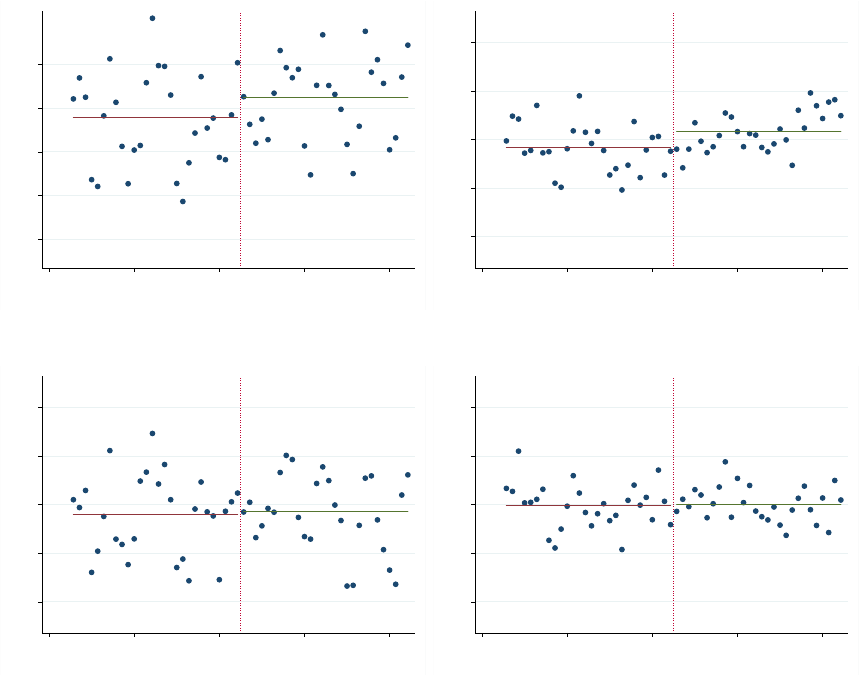
Figure 5: Bargaining Success Rates
.44 .45 .46 .47 .48
Success Rate
22apr2016 06may2016 20may2016 03jun2016 17jun2016
Day
(a) Desktop: Raw
−.02 −.01 0 .01 .02
Residual
22apr2016 06may2016 20may2016 03jun2016 17jun2016
Day
(b) Desktop: Residuals
.39 .4 .41 .42 .43
Success Rate
22apr2016 06may2016 20may2016 03jun2016 17jun2016
Day
(c) Mobile: Raw
−.02 −.01 0 .01 .02
Residual
22apr2016 06may2016 20may2016 03jun2016 17jun2016
Day
(d) Mobile: Residuals
Notes: Panels (a) and (c) depict scatterplots of the raw daily success rates for bargaining interactions grouped by
the date of the first offer for desktop and mobile, respectively. Panels (b) and (d) depict residuals from a linear
probability model regressing a dummy for successful bargaining on a large series of covariates (ln(ask price); category
by condition fixed effects; day of week, precipitation, and holiday dummies and the temperature) for desktop and
mobile, respectively. The vertical axes on both plots are scaled identically subject to a location shift.
half a percent. Two other features are apparent—first, there is substantial variation
between days in the success rate of bargaining interactions, although this is rather
smaller when we condition on the set of controls. Second, and more importantly, it
appears that there is a positive drift in the residuals during the post period. In Section
5 we will offer a simple economic explanation for this finding: buyers and sellers are
learning to communicate in the weeks following the policy change, leading to new
behavior and better outcomes.
Consistent with models (3) and (4) of Table 3, we see no evidence of change in
the likelihood that interactions are successful for buyers using the mobile platform..
18

We also see no positive drift in the residuals in the post period. This rationalizes our
finding for the difference in differences estimator
ˆ
β
C
dd
in models (5),(6),(7), and (8).
4.2.3 Week-Specific Treatment Effects: Parallel Trends and Dynamics
Next, we estimate a variant of (4) with week-specific effects over our eight-week sample:
1(success) = β
0
dd
+ Xβ
1
dd
+ P β
2
dd
+ Dβ
3
dd
+
X
t
P D · 1(week t)β
C,t
dd
+ ε. (6)
We are interested in this model for two reasons. First, the divergence in the residualized
scatterplots for desktop, Figure 5(b), and mobile, Figure 5(d), in the post-treatment
period suggest that the effect of communication on bargaining is not immediate but
delayed. Estimating week-specific effects will allow us to characterize these dynamics.
Second, following Autor (2003), estimating week-specific effects in the pre-period
allows a partial test of the parallel trends assumption. If estimated week-specific
effects in the pre-period are significant, this would violate Granger causality—that is,
the effect would precede the cause, marking a failure of our identifying assumptions.
Results are depicted in Figure 6. We normalize the effect for week zero (just before
the policy change) to zero. In the pre-period, our test of the joint significance of the
coefficients fails to reject with a F-statistic of 0.11 (and an associated critical
p
value
of 0.9550). Therefore, we find neither a violation of the parallel trends assumption nor
of Granger causality for our sample. Furthermore, the model permits us to interpret
the positive drift in the post period from Figure 5(b) as a time-variant effect of
communication. Despite almost instantaneous adoption, it took several weeks for the
effects to be fully seen in the probability of bargaining success—this is perhaps not
surprising, as conventions for communication may have taken some time to stabilize.
19
We investigate this further with the content of the messages in Section 5.
4.3 Additional Specifications and Outcomes
Next, we summarize results from additional specifications, all of which are discussed
in more detail in the Appendix.
We are interested in the effect of communication on other bargaining outcomes
besides breakdown, especially in the hope that this might help us understand mecha-
19
In Appendix 1 we estimate week-specific effects for the longer sample and show that the effect of
communication on bargaining success stabilized and was consistent after week five.
19
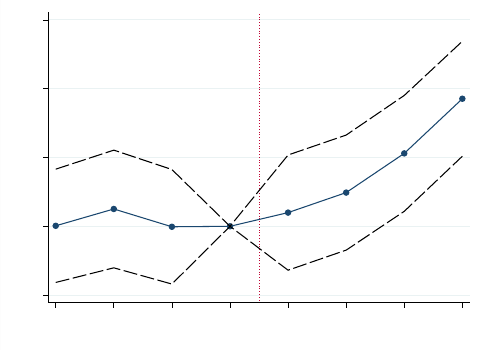
Figure 6: Week-Specific Effects
−.005 0 .005 .01 .015
Estimated Effect on Success Rate
−3 −2 −1 0 1 2 3 4
Week
Notes: This figure depicts week-specific effects using the diff-in-diff approach with the main sample, 4 weeks before
and 4 weeks after the policy change. The omitted coefficient (normalized to zero) is the week just prior to the change.
Dashed lines represent a 95% confidence interval with heteroskedacticity-robust standard errors clustered by seller.
nisms and distributional consequences. With the caveat of limited power, we document
our efforts in Appendix B. We find no statistically significant effects on the number of
rounds or the first offer, but we do see a strong negative effect on the agreed-upon
price. Examining this more closely, we condition on who made the final (accepted)
offer in that sample, and find suggestive evidence that bargainers are successfully
using messages to not only close the deal, but also to obtain more of the surplus.
In addition, in Appendix C we investigate heterogeneous treatment effects across
asking price ranges and categories. Here our limited power is binding, however we find
suggestive evidence that the effects are somewhat larger at lower price ranges (however,
this is substantially flattened when we consider proportional effects, as success rates
are much lower for higher asking price products).
Also, in Appendix D we consider robustness checks along two dimensions: first,
the window used to construct the estimation sample and second, the inclusion of seller
fixed effects. Both are supportive of the results of Table 3. We note that shortening
the sample makes the effects no longer statistically significant, as one might intuit
from Figure 6; that in extending it, the upward trend in Figure 6 stabilizes, and that
seller fixed effects somewhat attenuate the result (from 0.0773 to 0.0561).
20

5 Evidence of Learning from Text Analysis
In Section 4, we found a positive and significant relationship between bargaining
efficiency and messaging. Moreover, by analyzing the week-specific effects of messaging,
we observed that it took time for the full effect of communication to materialize. In
this section, we explore the messages themselves in order to offer a plausible economic
story for the strengthening relationship between messaging and bargaining success.
We compute the change in messaging content across weeks for both buyers and
sellers, and are able to uncover some compelling patterns in messaging content.
Namely, we find that messages sent by repeat sellers, or sellers who are sending
multiple messages in our sample, are becoming more similar in content as the weeks
pass. We additionally find convergent patterns in seller messages: specifically, the rate
at which seller messages are changing is decreasing. These trends in seller messages are
consistent with experience-based learning in which sellers adopt messaging strategies
over time. We do not find similar results for buyers, where there are far fewer who are
sending multiple messages in our sample.
5.1 Messaging Data
We have 248,722 messages of buyer and seller interactions for the ten-week period
succeeding the introduction of messaging beginning on May 25, 2016.
20
We process
these messages through the following steps: First, we identify and keep only the
messages sent in German in order to maintain a common corpus of words for our
analysis; this makes up the vast majority (81.1 percent) of our dataset with the next
most common language being English (which accounts for 6.4 percent of the messages).
Second, the lower-cased messages are stripped of non-alphabetic characters, urls, extra
spaces, and a list of common stop words—these are words such as “and” and “the”
that provide little meaning in our messages. We then apply NLTK’s German Snowball
Stemmer (Bird et al. (2009)) to the tokens (ie. words) in each message so that they are
transformed to their original stems. For instance, the word “angeboten” (“offered”) is
minimized to “angebot” (“offer”). This step is common practice in natural language
processing and allows us to consider effectively synonymous words as the same word.
21
20
Our textual analysis starts two days after the change due to low take up on May 23-24, 2016.
21
Please refer to Appendix Section E2 for a more detailed discussion of the construction of our
messaging dataset, including a description of the list of stop words we remove from our dataset.
21

Table 4: Buyer and Seller Messaging Characteristics Based on Experience
Number of Messages Unique Individuals Average Message Length Success Frequency
Buyer
All Messages 93576 76415 9.293 0.309
One Message 64648 64648 9.250 0.339
Two - Four Messages 25595 11271 9.379 0.244
Five+ Messages 3333 496 9.475 0.240
Seller
All Messages 116081 60076 8.513 0.228
One Message 40350 40350 8.218 0.243
Two - Four Messages 40541 16375 8.561 0.213
Five+ Messages 35190 3351 8.796 0.227
Notes: In the first column messages are split based on whether the message’s corresponding buyer or seller sent one,
two to four, or five plus messages. Average message length refers to the average number of tokens in each message for
that group. Success is defined by whether that message ends in a sale.
The final reduced dataset amounts to 209,658 messages split into 93,577 buyer
messages and 116,081 seller messages. Table 4 provides descriptive statistics for buyer
and seller messages split by experience level, which we define as the total count of
messages sent by that seller or buyer over the ten-week period. Here we see that
buyers tend to be “short-run” players, with only 496 buyers sending five or more
messages. In contrast, individual sellers are more persistent in our dataset—there are
3,351 who are sending five or more messages.
Next, Table 5 depicts the ten most common tokens for buyers and sellers. Here,
sellers messages appear to be slightly more negative in messaging content as “not”
is the second most common word; additionally, “unfortunately” is the eighth most
frequent token to appear in seller messages. For a more thorough description of the
messages in our dataset, see Appendix Section E.
5.2 Empirical Challenges and Methods
Representing textual data constitutes a unique and increasingly common challenge
in empirical research. In order to analyze seller and buyer messages, we must first
construct a measure for the content of each message.
To do this, we split each message into a series of bigrams, a two-word pairing
formed from consecutive words. For example, message
m
as “this is my last offer”
would be broken up into the parts: [“this is,” “is my,” “my last,” and “last offer”].
Splitting the messages into bigrams, rather than single-word tokens, allows us to
22

Table 5: Buyer and Seller Most Common Tokens
Rank Buyer Token Translation Frequency Seller Token Translation Frequency
1 Hallo Hello 0.031 Nicht Not 0.032
2 Wurd Would 0.030 Hallo Hello 0.024
3 Gruss Greeting 0.025 Gruss Greeting 0.023
4 Versand Shipping 0.018 Preis Price 0.021
5 Nicht Not 0.016 Euro Euro 0.020
6 Euro Euro 0.015 Versand Shipping 0.016
7 Mfg Kind regards 0.011 Leid Unfortunately 0.015
8 Dank Thanks 0.011 Dank Thanks 0.013
9 Kauf Purchase 0.010 Schon Beautiful 0.012
10 Preis Price 0.010 Mfg Kind regards 0.011
Notes: This table reports the frequency of the ten most common tokens in our processed dataset for buyers and sellers.
Tokens are translated to English for readability.
simplify each message while still incorporating some level of context in our textual
analysis. An example of this are the words “screw” and “you,” put together “screw
you” has a much stronger meaning than the two words apart.
Next, we collapse our data into what is known as a “bag-of-words,” or in our
case, a “bag-of-bigrams,” where each message is a row and each bigram a column.
This exercise is frequently used in natural language processing (see Gentzkow et al.
(2019a)); however, as analyzing textual data is still relatively new to economics, we
will detail what this means below.
Our bag-of-bigrams is in the form of the matrix
C
i
, where element
c
i,mj
corresponds
to the number of counts for phrase
j
in message
m
for group
i
, ie. some group of buyers
or sellers.
C
i
is a high dimensional matrix. For instance,
C
s
for all seller messages
in our dataset makes up a 116,081-by-287,241 matrix accounting for 116,081 seller
messages and the 287,241 distinct bigrams that appear in these messages. Similarly,
C
b
for buyer messages forms a matrix with dimensions 93,577-by-331,904.
We are interested in changes in messaging content at the weekly level: Thus, we
collapse
C
i
to
C
0
i
.
C
0
i
is a ten-by-
X
matrix with each row corresponding to a week
in our ten-week sample and
X
representing the number of distinct bigrams sent by
group
i
. Element
c
0
i,wj
then equates to the number of times phrase
j
appears in the
messages sent during week w by group i.
Finally, we take vector
v
w
from row
w
of
C
0
i
and compute the cosine distance
between
v
w
and all rows in
C
0
i
. The cosine distance between vector
v
w1
and
v
w2
is
23

given by
1 −
v
w1
· v
w2
|v
w1
||v
w2
|
, (7)
where · represents the dot product and |v
w
| is the `
2
norm.
The cosine distance measures one minus the cosine of the angle between
v
w1
and
v
w2
and is a standard method for computing text dissimilarity. The normalizing term
in the denominator of
(7)
is desirable in our case as it scales the distance between
the two vectors by each vector’s length. This is essential in our context as the sum
of bigram counts varies week from week due to changes in the take-up of messaging,
holidays, etc. Finally, the cosine distance is our metric of choice as it supplies an
intuitive measure of the distance between bigram counts across weeks. Since our
vectors are by construction composed of nonnegative values, the cosine distance in
this case will always be in the range [0
,
1]
.
Here, two weeks with orthogonal vectors
will have a cosine distance of 1, whereas the cosine distance will approach 0 as the
two vectors get more similar in counts.
Finally, in order to clearly present the cosine distances across each pairing of
weeks, we construct a ten-by-ten matrix of cosine distances with the
w
1
w
2
th element
corresponding to the cosine distance between the vector of bigram counts in week
w
1
and the vector of bigram counts in week w
2
.
5.3 Dynamics of Communication by Experience
In Figure 7, we present our results through a heat map depicting the cosine distances
between the bigram counts across weeks for buyers, Panel (a), and sellers, Panel
(b). The colors indicate cosine distances in which the lighter boxes convey greater
differences in messaging content, while the messages get more similar as the boxes get
darker.
In Panel (a) of Figure 7, the cosine distances between buyer messages is stable
across our ten-week period; we can see this as all the boxes in the heat map appear to
be similar shades of blue. Table 4 offers a plausible explanation for this consistency in
buyer messages across weeks: There are few buyers in our sample sending multiple
messages. Specifically, only 3,333 messages are sent from buyers whose total message
count is five or more. In contrast, 35,190 messages are sent by sellers with five or more
messages. Due to the lack of repeat buyers, any changes in Panel (a) are presumably
24

Figure 7: Cosine Distance of Buyer and Seller Messages by Week following the
Introduction of Messaging
(a) Buyer (b) Seller
Notes: This figure presents the cosine distance of the bigram counts in the messages between each of the ten weeks
following May 25, 2016, for buyers, in Panel (a), and sellers, in Panel (b).
due to noise and week-effects. For instance, we observe differential usage of the word
“urlaub” or “vacation” in our sample. Buyer messages include “vacation” 61 times
during the week of July 20th, while they only mention “vacation” 21 times during the
first week of our sample (May 25 – 31).
Panel (b) of Figure 7 portrays starkly different results; here, there are clearly
changes in content across sellers messages from week to week as made evident due to
the patterns of color occurring in seller messages. Still, it is challenging to discern
exactly how seller messages are transforming. In order to amend this, there are two
ways in which we can more intuitively decipher the patterns presented in the heat
maps. First, we can more closely observe the bottom gradient of the heat maps, where
we are comparing the differences in messaging content between week w and week 10.
Second, we can plot the off-diagonals of the heat maps in order to see the rate of
change in message content. The former will tell us whether the content of the text is
changing systematically, where the latter will tell us whether it is convergent. That is,
if the rate of change is decreasing, we take this as evidence of the convex pattern that
is signature of models of learning and information: that our first data points teach us
more than those that follow.
Figure 8 depicts a plot of the the cosine distances between week
w
and week ten
(the bottom gradient) for buyers and sellers. In this figure, we also depict the results
25

for (nested) subsamples with different experience levels, where we define experience by
the number of messages sent by that seller/buyer over our entire sample. Separating
by experience level will allow us to isolate the sellers for whom we are more likely to
observe patterns of learning. The scale of each plot is normalized to 1 in the last week;
we do this because sampling variation, which is more salient as we restrict the sample
size, biases the cosine distance measure upwards and makes levels uninterpretable.
22
Note also that the scales of panels (a) and (b) are different.
Panel (a) depicts the differences in messages between week
w
and week 10 for
buyers. The line for “All” includes all buyers, and corresponds directly to the values
in the bottom row of the heat map in panel (a) of Figure 7. For buyers with one, two,
or three or more messages, the cosine distance does not appear to be changing. For
buyers with four, five, and six or more messages, the cosine distance is decreasing over
time, but this is obscured by sampling variation due to the small number of buyers in
these sets.
In Panel (b), we again observe sharply different results for sellers. Here again, the
line for “All” includes all sellers, and corresponds directly to the values in the bottom
row of the heat map in panel (b) of Figure 7. For all samples, we see that as the
weeks get closer to week 10, seller messages are increasingly more similar in content
to the messages from this last week. Note also that the change is more pronounced
among more experienced sellers. For instance, we see the sharpest trend for sellers
that sent 6 or more messages, where there is a substantial difference in the cosine
distance between the set of week 1 and 10 messages and the set of week 9 and 10
messages. These patterns suggest that as the weeks pass, sellers may be adopting new
messaging strategies; moreover, it appears that repeat sellers are driving the changes
in Figure 7.
So far, we have established that repeat sellers’ messaging strategies are changing as
they accumulate experience. We would like to ask whether, in addition, the changes
are convergent, i.e. whether they represent a pattern that reflects learning. To do this,
we plot the cosine distance across different periods of the same length to see whether
the differences in message content are decreasing at a slower or faster rate over time.
The objects we are depicting correspond to the off-diagonal elements of the heat map
in Figure 7. The different off-diagonals represent differences over varying lengths of
22
See Appendix Figure A-6 for the non-normalized version.
26

Figure 8: The Bottom Gradient for Buyers and Sellers with Different Experience
Levels
(a) Buyer (b) Seller
Notes: This figure presents the cosine distance between the messages sent in weeks x and 10 for buyers, Panel (a),
and sellers, Panel (b). The cosine distance is scaled by the distance between week 9 and week 10 messages. Each
panel is cut by groups, where All includes our entire sample of buyers/sellers, 2+ indicates our sample of messages
sent by buyers/sellers who sent 2 or more messages, 3+ from our sample of messages sent by buyers/sellers who sent
3 or more messages, and so on.
time; we depict them all because we are concerned that high-frequency differences
may exaggerate the ratio of noise to signal.
Figure 9, plots the off-diagonals for all buyers, Panel (a), and sellers, Panel (b). In
this plot, ∆
x
for week
w
corresponds to the cosine distance in messages between week
w
and week
w − x.
As suspected, Panel (c) portrays a noisy plot with no obvious
patterns in buyer messages; on the other hand, there appears to be a downward trend
in the ∆
x
’s in Panel (d). Thus, while seller messages are becoming more similar over
time, they do so at a declining rate.
Figure 9 depicts the off-diagonals corresponding to the “All” groups of Figure 8,
but from the latter we saw that repeat sellers are changing their messaging content
more than transient ones. So, in Figure 10 we reproduces the same exercise for sellers
who sent 5 or more messages in our ten-week period. As a reference point, the heat
map for this group of sellers is depicted in Panel (a). Already, we see starker patterns
in the change in message content across weeks. Panel (b) presents the off-diagonal
plot for this group of sellers. Again, the patterns that previously emerged for our
entire dataset of sellers become much more explicit when we restrict our analysis to
repeat sellers. For instance, from ∆5 in Panel (b) we can see that sellers’ messages
between weeks 8 and 3 are more similar than in comparison to the messages for weeks
27
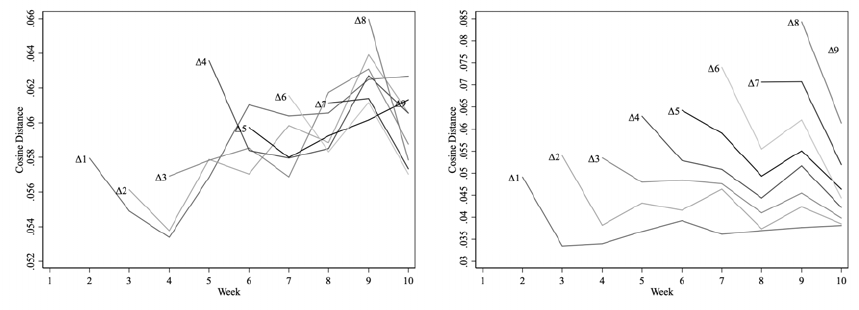
Figure 9: Off-Diagonals for Buyers and Sellers
(a) Buyer (b) Seller
Notes: This figure displays the change in cosine distance of bigram counts in the messages for different periods of
time following May 25, 2016, separately for buyers, in Panel (a), and sellers, in Panel (b). ∆x for week w indicates
the cosine distance between week w and week w − x.
7 and 2 and weeks 6 and 1. Or in other words, as repeat sellers learn to use similar
messaging strategies over time, they are doing so at a declining rate as the weeks pass.
This convergent path in which sellers are changing their messaging content faster in
the beginning weeks following the messaging intervention, and then more slowly as
time goes by, is consistent with experienced sellers learning how to use messages to
facilitate transactions.
Most importantly, these results offer a simple explanation for the dynamics seen
in Section 4.2.3, where we find a time-variant effect of communication on bargaining
success that stabilizes following week five.
Further evidence is offered in Figure A-4 of the Appendix where we have included
the heat maps and off-diagonal plots for sellers who sent two, three, and four or more
messages. In addition, Figure A-5 in the Appendix presents the results for both sellers
and buyers who appear only once in our dataset. Here, the effects presented above
are completely attenuated when looking at this group of sellers, further providing
evidence that these patterns of convergence are due to changes in messaging content
by experienced sellers.
28
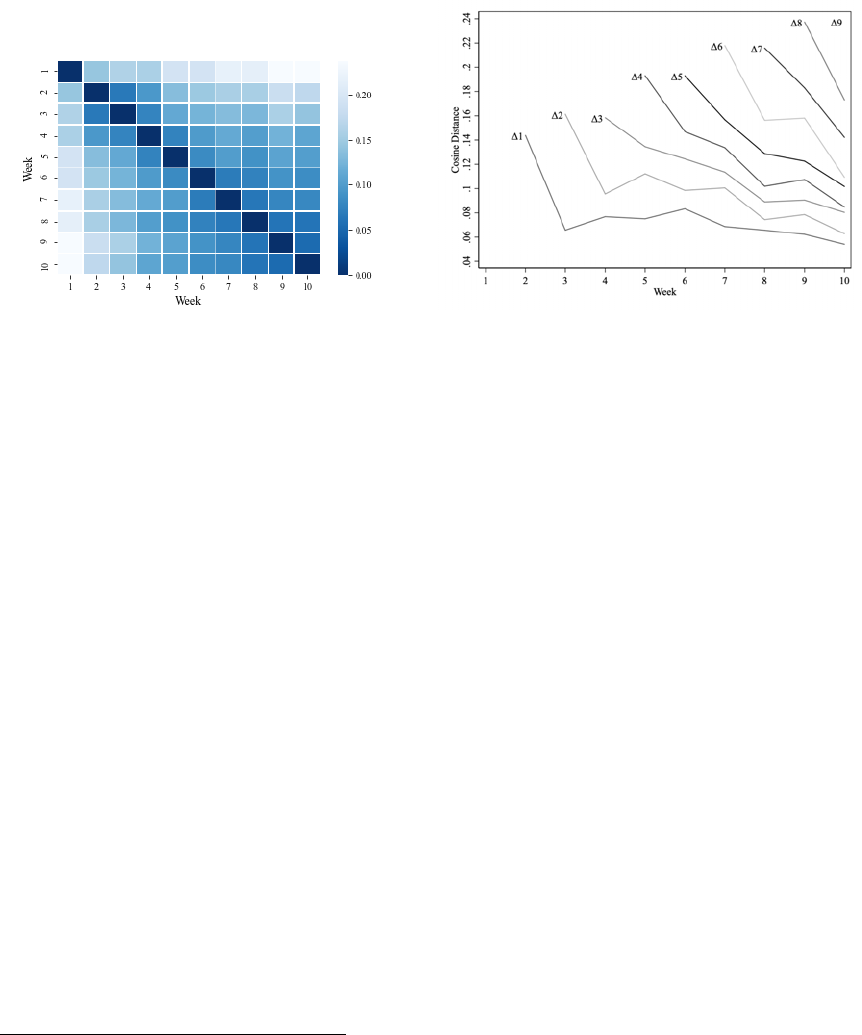
Figure 10: Convergence Among Sellers with Five or More Messages
(a) 5+ Messages (b) 5+ Messages
Notes: Panel (a) depicts the heat map representing the cosine distance of the bigram counts in the messages for each
pairing of weeks following May 25, 2016 for sellers that sent five or more messages. Panel (b) plots the off-diagonals
of the heat map from (a). ∆x for week w indicates the cosine distance between week w and week w − x.
6 Message Experience Predicts Success
In Section 4.2.3, we found a time-variant effect of communication on the success rate
of bargaining; namely, it took several weeks for the full effect on the success rate
to manifest. Similarly, the results from Section 5.3 indicate that seller messages are
changing over time, and that they are doing so in a convergent pattern.
Given these findings, the natural next question is whether there exists a relationship
between the change in messaging content and bargaining success. Here, we are
motivated by the bottom gradient trends in Panel (b) of Figure 8. This figure shows
that seller messages are becoming more similar as the weeks approach week 10.
To explore whether these changes are associated with shifts in the seller success
rate, we calculated the cosine similarity between each message and the aggregated set
of bigram counts from the messages sent by sellers in week 10. We regress message
success, a binary variable representing whether that seller’s message ended in a sale,
onto this cosine similarity measure.
23
23
In this analysis we exclude a small set of sellers who send more than 20 messages. We do
this because we believe that a) they are qualitatively different, professional sellers and b) they are
overrepresented in message-level regressions. Overall, we are dropping 217 sellers that sent 21 or
more messages; this is out of our original sample of 60
,
076 sellers. In Appendix Section 4 we report
variations, including using all sellers and the set of sellers that sent fewer than 11 messages.
29

Table 6: The Relationship Between Message Success and Cosine Similarity
(1) (2) (3)
Sim(m, week 10) 0.0661
∗
0.0559
∗
0.0490
(0.0226) (0.0227) (0.0428)
Message Length 0.0013
∗
0.0003
(0.0002) (0.0005)
N 101931 101931 62217
Controls X X X
Seller FE X
Notes: This table presents our results on message success and a measure of message experience. Sim(m, week 10)
is the cosine similarity between a message and the set of week 10 messages excluding sellers who sent more than 21
messages. All models include our main set of controls: time trend; ln(ask price); category by condition fixed effects;
day of week, precipitation, holiday dummies, and the temperature. Likewise, all models drop sellers sending more
than 20 messages. Model (3) includes seller fixed effects. Robust standard errors are reported in parentheses and
∗
denotes statistical significance at α = 0.05.
Table 6 presents our results. In all specifications we include the same set of controls
as documented in Section 3.2. Finally, Models (2) and (3) also control for message
length, as measured by the number of tokens in the processed message. Model (3)
includes seller fixed effects.
In Model (1), we find a statistically significant effect that going from a completely
orthogonal message to a message containing the set of week 10 messages is associated
with an increase in the probability of success by 6
.
61 percentage points. In Model (2),
we further find that message length has a positive, but economically small, relationship
with the success rate. Finally, our result is no longer statistically significant, in Model
(3), when including seller fixed effects. We have only 3,134 sellers sending more
than five messages, but fewer than 21; as a result, we lose a considerable amount
of power in our estimates when restricting attention to within-seller variation. Still,
the relationship between our cosine similarity measures and message success remains
positive.
Altogether, Table 6 points to a positive correlation between the probability of
message success and the similarity between the message and the set of week 10 seller
messages. Notably, the point estimates from this table are similar in magnitude to
the point-estimates from Table 3, where we found that among our treatment group,
interactions that involved messages were 7.73 percentage points more likely to end in
success.
30

A limitation of our approach is that we have not been able to address the di-
rect mechanism in which messages contribute to higher rates of bargaining success.
While we cannot provide causal evidence on this front, we implement a distributed
multinomial model from Taddy (2015) in Appendix Section F. Here we consider the
relationship between the bigrams included in seller messages and the message number
sent by that seller, a measure of seller experience, which we have found to be related
to message success. This analysis attempts to further understand how seller messaging
content is changing, and through this descriptive exercise, we suggest some potential
strategies that sellers may be implementing.
Table A-7 then presents the bigrams, both in English and the original German,
that are the most and least predictive of seller experience, conditional on a set of
controls. In addition, we use the bigram coefficients estimated from our model to
compute message experience scores; here, a higher score indicates a message associated
with higher levels of seller experience. Table A-8 then shows the messages with the
highest experience scores, while Table A-9 includes the messages with the lowest
scores.
Among the messages that are most correlated with experience, we see an emphasis
on costs, especially those which may not be salient to buyers, such as the eBay
commission.
24
This is consistent with prior work highlighting the effectiveness of
cost rationales originally raised by Kahneman et al. (1986), and re-emphasized in a
bargaining setting by Lee and Ames (2017). The latter work contrasts cost rationales
with disparagement rationales, showing the latter to be ineffective. With respect to
this, our focus on seller messages obviates disparagement, however we do observe that,
among those messages least predictive of experience, arguments about the quality of
the product are common. We also see that where those most correlated with experience
are restrained, polite, and precise, those less so tend to use more effusive language,
which is reminiscent of the finding, by Jeong et al. (2019), that warm language may
be counterproductive in negotiations.
24
The price that the buyer pays is not received by the seller. Instead, the platform takes a “final
value fee” in the range of 10%. Buyers who have never been on the other side of the marketplace
might easily be unaware of this fact.
31
7 Discussion
In this paper we exploited a natural experiment in the availability of text messaging
in bargaining to study the role of cheap-talk communication in avoiding bargaining
breakdown. We found a statistically and economically significant effect: bargainers
who used the messaging feature were on average eight percentage points more likely
to transact. Against the sample average success rate of forty-four percent, this implies
a fourteen percent reduction in the likelihood of bargaining breakdown.
We are unaware of any prior empirical work on communication in bargaining,
however our results are consistent with a line of thought from the experimental and
theoretical literature that suggests a role for behavioral considerations in bargaining.
These papers have found that players communicate “too much” to be rationalized by
rational models of cheap talk, and offer suggestive evidence that communication allows
bargainers to outperform theoretical upper bounds to bargaining efficiency in the
canonical, rational model with incomplete information. From the perspective of the
literature, our results cast a positive light on efforts to test models that incorporate
behavioral components to understand the role of communication (Miettinen, 2013;
Dufwenberg et al., 2017).
From a market design perspective, our results suggest that communication has an
important role to play in fostering transactions. However, this analysis has sidestepped
a competing concern of platforms: that allowing communication may enable parties
to take their transactions off the platform to avoid fees. Conspicuously, among the
three largest online platforms that allow bargaining, Amazon both charges the highest
transaction fee and does not facilitate communication between buyers and sellers.
While we have no data on such off-platform transactions and cannot speak to their
frequency, we do note that they would appear as bargaining failure in our dataset.
Therefore, if communication is facilitating bargainers taking transactions offline, our
results can be interpreted as net of any such effect, and in that sense a conservative
estimate of the effect of communication on breakdown.
Our finding that communication plays an important role in bargaining raises at
least as many questions as it answers, and we believe this is an important area for
continued work. A promising direction that we have broached but not exhausted is
to use developments in natural language processing and text analysis to study the
content of what people say, above and beyond the fact that they say something. These
32
questions have already been raised in experimental settings (see Lee and Ames (2017)
for a recent contribution to, and summary of, this literature in social psychology).
The availability of data from online bargaining marketplaces is an opportunity to see
them in the field and directly link them to economic outcomes. Understanding how to
improve bargaining outcomes is among the most central questions in economics, and
also among the questions on which we have made the least progress, in part due to
a lack of empirical work using data from real market interactions. Our paper tries
to fill some of that gap, and our results highlight the importance of communication
in bargaining. As Farrell and Gibbons (1989) write, “the economic importance of
costless, nonverifiable, informal communication is much greater than its role in the
literature suggests.” Our result documents empirically that this remains true today.
33

References
Angrist, Joshua D., Guido W. Imbens, and Donald B. Rubin
, “Identification of Causal
Effects Using Instrumental Variables,” Journal of the American Statistical Association, 1996, 91
(434), 444–455.
Autor, David
, “Outsourcing at Will: The Contribution of Unjust Dismissal Doctrine to the Growth
of Employment Outsourcing,” Journal of Labor Economics, 2003, 21 (1), 1–42.
Awaya, Yu and Vijay Krishna
, “On Communication and Collusion,” American Economic Review,
2015, 106 (2), 285–315.
Ayres, Ian and Barry Nalebuff
, “Common Knowledge as a Barrier to Negotiation,” UCLA Law
Review, 1997, 44 (6), 1631–1660.
Backus, Matthew, Tom Blake, and Steven Tadelis
, “On the Empirical Content of Cheap-Talk
Signaling: An Application to Bargaining,” The Journal of Political Economy, 2019, 127 (4),
1599–1628.
, , Bradley Larsen, and Steven Tadelis
, “Sequential Bargaining in the Field: Evidence
from Millions of Online Bargaining Interactions,” Quarterly Journal of Economics, 2020, 135 (3),
1319–1361.
Belkin, Liuba Y, Terri R Kurtzberg, and Charles E Naquin
, “Signaling Dominance in Online
Negotiations: The Role of Affective Tone,” Negotiation and Conflict Management Research, 2013,
6 (4), 285–304.
Bird, Steve, Edward Loper, and Ewan Klein
, in “Natural Language Processing with Python,”
O’Reilly Media Inc., 2009.
Blume, Andreas and Andreas Ortmann
, “The Effects of Costless Pre-Play Communication:
Experimental Evidence from Games with Pareto-Ranked Equilibria,” Journal of Economic Theory,
2007, 132 (1), 274–290.
Bolton, Gary E., Kalyan Chatterjee, and Kathleen L. McGinn
, “How Communication Links
Influence Coalition Bargaining: A Laboratory Investigation,” Management Science, 2003, 49 (5),
583–598.
Brown, Jennifer Gerarda and Ian Ayres
, “Economic Rationales for Mediation,” Virginia Law
Review, 1994, 80 (2), 323–402.
Cabral, Luis and J´ozsef S´akovics
, “Must Sell,” Journal of Econoomics and Management Strategy,
1995, 4 (1), 55–68.
Cai, Hongbin and Joseph Tao-Yi Wang
, “Overcommunication in Strategic Information Trans-
mission Games,” Games and Economic Behavior, 2006, 56, 7–36.
Card, David and Gordon Dahl
, “Bargaining and the Role of Expert Agents: An Empirical Study
of Final-Offer Arbitration,” The Review of Economics and Statistics, 2012, 94 (1), 116–132.
Charness, Gary
, Communication in Bargaining Experiments, Vol. Oxford Handbook of Economic
Conflict Resolution, Oxford University Press,
and Martin Dufwenberg
, “Promises and Partnership,” Econometrica, 2006, 74 (6), 1579–1601.
34

and , “Participation,” American Economic Review, 2011, 101, 1211–1237.
Clark, Robert and Jean-Fran¸cois Houde
, “The Effect of Explicit Communication on Pricing:
Evidence from the Collapse of a Gasoline Cartel,” The Journal of Industrial Economics, 2014, 62
(2), 191–228.
Coffman, Lucas and Paul Niehaus
, “Pathways of Persuasion,” Games and Economic Behavior,
2020, 124, 239–253.
Cooper, David J. and Kai-Uwe K¨uhn
, “Commuication, Renegotiation, and the Scope for
Collusion,” American Economic Journal: Microeconomics, 2014, 6 (2), 247–278.
Cooper, Russel, Douglas V. DeJong, Robert Forsythe, and Thomas W. Ross
, “Commu-
nication in Coordination Games,” Quarterly Journal of Economics, 1992, 107 (2), 739–771.
Crawford, Vincent P.
, “A Theory of Disagreemnt in Bargaining,” Econometrica, 1982, 50 (3),
607–637.
, “Explicit Communication and Bargaining Outcomes,” American Economic Review, 1990, 80 (2),
213–219.
and Joel Sobel
, “Strategic Information Transmission,” Econometrica, 1982, 50 (6), 1431–1451.
, Miguel A. Costa-Gomes, and Nagore Iriberri
, “Structural Models of Nonequilibrium
Strategic Thinking: Theory, Evidence, and Applications,” Journal of Economic Literature, 2013,
51 (1), 5–62.
Doraszelski, Ulrich, Gregory Lewis, and Ariel Pakes
, “Just Starting Out: Learning and Price
Competition in a New Market,” 2017. accepted, American Economic Review.
Dufwenberg, Martin, Maro˘s Serv´atka, and Radovan Vadovi˘c
, “Honesty and Informal Agree-
ments,” Games and Economic Behavior, 2017, 102, 269–285.
Ellingsen, Tore and Robert
¨
Ostling
, “When Does Communication Improve Coordination?,”
American Economic Review, 2010, 100, 1695–1724.
Ert, Eyal, Stephanie Creary, and Max H. Bazerman
, “Cynicism in Negotiation: When
Communication Increases Buyers’ Skepticism,” Judgement and Decision Making, 2014, 9 (3),
191–198.
Farrell, Joseph and Robert Gibbons
, “Cheap Talk Can Matter in Bargaining,” Journal of
Economic Theory, 1989, 48 (1), 221–237.
Fey, Mark and Kristopher W. Ramsay
, “When is Shuttle Diplomacy Worth the Commute?
Information Sharing through Mediation,” World Politics, 2010, 62 (4), 529–560.
Gentzkow, Matthew, Bryan Kelly, and Matt Taddy
, “Text as Data,” Journal of Economic
Literature, 2019, 57 (3), 535–574.
, Jesse M Shapiro, and Matt Taddy
, “Measuring Group Differences in High-dimensional
Choices: Method and Application to Congressional Speech,” Econometrica, 2019, 87 (4), 1307–
1340.
Gibson, Ranja, Carmen Tanner, and Alexander Wagner
, “Preferences for Truthfulness:
Heterogeneity Among and Within Individuals,” American Economic Review, 2013, 103 (1),
532–548.
35

Gizatulina, Alia and Olga Gorelkina
, “Selling ‘Money’ on eBay: A Field Study of Surplus
Division,” 2017. Working Paper.
Gneezy, Uri
, “Deception: The Role of Consequences,” The American Economic Review, 2005, 95
(1), 384–394.
Goltsman, Maria, Johannes H¨orner, Gregory Pavlov, and Francesco Squintani
, “Media-
tion, Arbitration, and Negotiation,” Journal of Economic Theory, 2009, 144 (4), 1397–1420.
Harrington, Joseph E. and Lixin Ye
, “Collusion through Coordination of Announcements,” The
Journal of Industrial Economics, 2019, 67 (2), 209–241.
Hine, Michael J, Steven A Murphy, Michael Weber, and Gregory Kersten
, “The Role of
Emotion and Language in Dyadic E-Negotiations,” Group Decision and Negotiation, 2009, 18 (3),
193–211.
H¨orner, Johannes, Massimo Morelli, and Francesco Squintani
, “Mediation and Peace,”
Review of Economic Studies, 2015, 82 (4), 1483–1501.
Jeong, Martha, Julia Minson, Michael Yeomans, and Francesca Gino
, “Communicating
with Warmth in Distributive Negotiations is Surprisingly Counterproductive,” Management Science,
2019, 65 (12), 5813–5837.
Kahneman, Daniel, Jack L. Knetsch, and Richard Thaler
, “Fairness as a Constraint on
Profit Seeking: Entitlemenets in the Market,” American Economic Review, 1986, 76 (4), 728–741.
Kopelman, Shirli, Ashleigh Shelby Rosette, and Leigh Thompson
, “The Three Faces of Eve:
Strategic Displays of Positive, Negative, and Neutral Emotions in Negotiations,” Organizational
Behavior and Human Decision Processes, 2006, 99 (1), 81–101.
Lee, Alice J. and Daniel R. Ames
, ““I Can’t Pay More” Versus “It’s not Worth More”: Divergent
Effects of Constraint and Disparagement Rationales in Negotiations,” Organizational Behavior
and Human Decision Processes, 2017, 141, 16–28.
Loertscher, Simon and Leslie M. Marx
, “Countervailing Power, Integration, and Investment
under Incomplete Information,” 2020. Working Paper.
McGinn, Kathleen L., Katherine L. Milkman, and Markus N¨oth
, “Walking the Talk in
Multiparty Negotiation: An Experimental Investigation,” Journal of Economic Psychology, 2012,
33 (1), 278–291.
, Leigh Thompson, and Max H. Bazerman
, “Dyadic Processes of Disclosure and Reciprocity
in Bargaining with Communication,” Journal of Behavioral Decision Making, 2003, 16, 17–34.
Menzio, Guido
, “A Theory of Partially Directed Search,” Journal of Political Economy, 2007, 115
(5), 748–769.
Miettinen, Topi
, “Promises and Conventions – An Approach to Pre-Play Agreements,” Games
and Economic Behavior, 2013, 80, 68–84.
Myerson, Roger B and Mark A Satterthwaite
, “Efficient mechanisms for bilateral trading,”
Journal of economic theory, 1983, 29 (2), 265–281.
Oberholzer-Gee, Felix and Julie Wulf
, “Alibaba’s TaoBao,” Technical Report 9-709-456, Har-
vard Business School 2009.
36
Radner, Roy and Andrew Schotter
, “The Sealed-Bid Mehanism: An Experimental Study,”
Journal of Economic Theory, 1989, 48 (1), 179–220.
Rubinstein, Ariel
, “Perfect Equilibrium in a Bargaining Model,” Econometrica, 1982, 50 (1),
97–110.
Taddy, Matt
, “Distributed Multinomial Regression,” The Annals of Applied Statistics, 2015, 9 (3),
1394–1414.
Valley, Kathleen, Leigh Thompson, Robert Gibbons, and Max Bazerman
, “How Commu-
nication Improves Efficiency in Bargaining Games,” Games and Economic Behavior, 2002, 38 (1),
127–155.
37
Appendices
A A Straw Man: OLS Estimates
In the absence of a natural experiment, one might have been tempted to analyze
the effect of communication by regressing a dummy for success on a dummy for the
presence of a message. This will be misleading if bargainers are more likely to send
messages when an interaction is, for reasons unobservable in our set of controls, less
likely to succeed. In Table A-1 we present OLS estimates for such an analysis in a
linear probability model approach.
Note that for these results we construct the message indicator a bit differently.
1
(Message
∗
) is actually
1
(complier), the product of three dummy variables: one for
whether any message was sent, one for whether the first offer in the interaction was
made after May 23, 2016 (to rule out misclassified messages), and one for whether
the buyer is a desktop user (to rule out cases where a message was sent by the seller
but the buyer could not read it because they were on the mobile app). In models (1)
through (4) we progressively add additional controls. The coefficient on
1
(Message
∗
)
responds most significantly at the inclusion of ln(Asking Price), which is intuitive
because messages are more common when bargaining over more expensive goods,
recalling Table 2. However, the coefficient stabilizes at a relatively slight 1.5 percentage
points, which is substantially lower than our estimated treatment-effect-on-the-treated
of approximately 8. We take this to mean that the endogenous decision of whether
to send a message is strongly negatively correlated with the error term in the OLS
regressions. That is, bargainers are more likely to use messages when the chances of
success are slight for reasons unobservable to the econometrician—evidence for this
already appears in the difference between models (1) and (2), where the inclusion of
the asking price removes some of the negative bias. Recall from Table 2 that messages
are more frequently sent when the asking price is greater, which is also where the
likelihood of breakdown is greater.
Appendix-1

Table A-1: OLS Estimates
(1) (2) (3) (4) (5) (6)
1(Message) -0.0076
∗
0.0208
∗
0.0152
∗
0.0151
∗
(0.0028) (0.0027) (0.0026) (0.0026)
ln(Ask Price) -0.0827
∗
-0.0840
∗
-0.0840
∗
-0.0840
∗
-0.0840
∗
(0.0013) (0.0013) (0.0013) (0.0013) (0.0013)
Time Trend 0.0000 0.0001 0.0000 0.0000
(0.0000) (0.0000) (0.0000) (0.0000)
1(Monday) 0.0115
∗
0.0115
∗
0.0114
∗
(0.0011) (0.0011) (0.0011)
1(Tuesday) 0.0073
∗
0.0074
∗
0.0069
∗
(0.0011) (0.0011) (0.0011)
1(Wednesday) 0.0046
∗
0.0046
∗
0.0043
∗
(0.0012) (0.0012) (0.0012)
1(Thursday) 0.0022
∗
0.0023
∗
0.0022
∗
(0.0011) (0.0011) (0.0011)
1(Friday) -0.0087
∗
-0.0086
∗
-0.0088
∗
(0.0013) (0.0013) (0.0013)
1(Saturday) -0.0106
∗
-0.0106
∗
-0.0108
∗
(0.0012) (0.0012) (0.0011)
1(Precipitation) -0.0014
∗
-0.0014
∗
-0.0008
(0.0007) (0.0007) (0.0007)
1(Holiday) -0.0072
∗
-0.0072
∗
-0.0078
∗
(0.0011) (0.0011) (0.0011)
Temperature 0.0006
∗
0.0006
∗
0.0006
∗
(0.0001) (0.0001) (0.0001)
Category by Condition FE X X X X
N 3294362 3294362 3294362 3294362 3294362 3294362
Notes: This table reports OLS coefficients from a linear probability model in which each observation is a bargaining
interaction and the dependent variable is a dummy for whether negotiations ended in a transaction. 1(Sunday) is
excluded. Heteroskedacticity-robust standard errors, clustered by seller, are reported in parentheses, and
∗
denotes
statistical significance at α = 0.05.
B Alternative Outcomes
The bulk of our analysis has taken a dummy for bargaining success as the dependent
variable. We might also be interested to know how other bargaining outcomes change
with the introduction of communication. For instance, do buyers negotiate better
deals? Is bargaining prolonged?
Appendix-2
Our results for these questions are presented in Table A-2. Models (1) and (2)
consider dependent variables for which we can use the entire sample: respectively, the
number of offers in the bargaining interaction and the log of the first buyer offer. We
find no statistically significant effect on either of these outcomes. In model (3) where
we condition on bargaining success and measure the effect on negotiated prices. We
find a strong negative effect. Note for models (2) and (3) that the controls include the
sellers’ asking price, so we can interpret this effect as a discount. One interpretation
is that sellers have raised their asking prices, but we find such general equilibrium
effects unlikely because of the low take-up rates of the messaging feature; also, we see
no compositional changes in the prices bargained in the pre- and post periods. This
leaves two additional hypotheses: first, that transactions that are new—that is, would
not have happened but for messaging—are on average for lower-priced products than
those that are not. This is consistent with the finding of Valley et al. (2002), as the
new transactions are on the frontier where buyer and seller valuations are close, as well
as our failure to find an effect on the buyer’s initial offer. An alternative interpretation
is that the composition of goods has not changed, but buyers are taking more of the
surplus.
Next, in models (4), (5), and (6) we dive further into the question of the division
of surplus. Here, we construct subsamples defined by the endogenous bargaining
sequence. Model (4) uses the asking price for the subsample where the buyer’s initial
offer is accepted (recall that buyers always make the first offer). Model (5) takes the
subsample in which the buyers initial offer was countered, and the seller’s counter-offer
was accepted. Finally, model (6) takes the subsample in which the buyer’s initial offer
was countered, then the buyer countered the seller’s counter, and the seller accepted
that counter-offer. In model (4) do we find an almost-significant effect. Moreover, the
sign changes between the models are consistent with the hypothesis that bargainers
are using messages to their own advantage. Note that the sample size shrinks fast
when conditioning on these small subsets, so it is unsurprising that we lack the power
to identify a significant effect.
Appendix-3
C Heterogeneous Effects
1 Effects by Price Range
Next, we present estimates of
β
C
iv
across different price categories in Table A-3. Our
estimates range from 8.98 to 10.44 percentage points for interactions where the asking
price is below
$
150, and they are substantively smaller—statistically insignificant with
point estimates ranging from 2.41 to 3.51 percentage points above $150.
While it seems as if there is a substantially larger effect of communication for
interactions that involve listings with lower asking prices, we note that this relationship
flattens out when we consider the baseline success rates. Interactions in the lowest-
price group (asking price less than
$
50) are successful 52.94 percent of the time, while
listings in highest-price group (asking prices above
$
250) are successful 25.54 percent
of the time. So the proportional effect is rather more similar—and not statistically
distinguishable—and therefore we hesitate to draw conclusions.
2 Variation Across Categories
We next turn to category-specific estimates of
β
C
iv
. However, we note two words of
caution: first, because the effects we are estimating are so small—from Table 3, on
the order of half a percent—splitting our sample quickly erodes power. In that spirit,
the standard errors should be interpreted with caution because a table with many
estimates implicitly suffers a multiple comparison problem. Similarly, the ordinal
relationships of the point estimates should be interpreted with substantial caution.
Second, we remind the reader that selection into the Best Offer mechanism is
endogenous. The composition of, for instance, CDs and DVDs conditional on enabling
Best Offer may be very different than CDs and DVDs more generally. While we may
think of the latter as being rather standardized, the former may be more likely to
include box sets and out-of-print collectors editions.
Estimates are presented in Figure A-1. The dependent variable remains a dummy
for whether the bargaining ended in a transaction. Standard errors are not adjusted
for the multiple comparison problem. While we find intuition in some of the findings,
e.g. the large effect in Collectibles, others remain a puzzle, e.g. the large effect in
Appendix-4
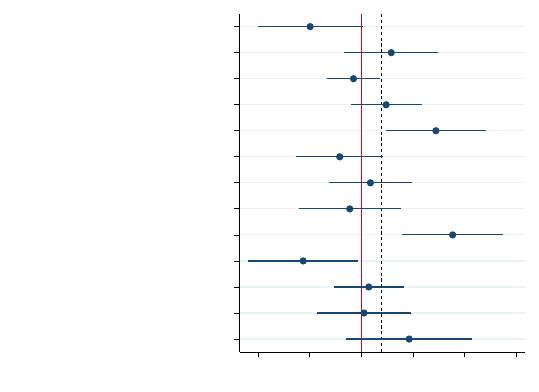
Figure A-1: Category-Specific Effects
Antiques & Art
Business & Industry
Car and Motorbike: Parts
Clothing & Accessories
Collectables
Computers, Tablets & Networking
Furniture & Living
Tools
Mobile Phones
PC & Video Games
Sports
TV, Video & Audio
Watches & Jewellery
−.4 −.2 0 .2 .4 .6
Notes: This figure presents category-specific estimates for all categories in our main sample with at least one hundred
thousand interactions. The dependent variable is a dummy for whether the bargaining interaction ended in a trans-
action. All parameters of the model are estimated independently for each coefficient estimate. The solid vertical line
is at zero, while the dashed vertical line is at our point estimate from Table 3 of 0.0773 for comparison.
Mobile Phones or the negative one in Antiques and Arts. For the reasons above, we
do not put much stock in these comparisons, ordinal or absolute.
D Robustness
1 Sample Window
As a simple robustness test, we check the sensitivity of our estimates to the sample
window. The main sample window is four weeks before and four weeks after the
change on May 23, 2016, depicted graphically in Figure 3. We also consider two, three,
five, and six weeks in either direction, as well as the full dataset, seven weeks before
and ten weeks after.
Table A-4 presents estimates varying the sample window. Consistent with the
finding that the effect of introducing communication is not immediate, results are
weaker for the shorter windows. This also reflects a loss of power as we lose observations.
Extending the window for a longer time horizon, the estimates stabilize, however this
may reflect other changes on the website. Consistent this, we also re-create Figure 6
for the full sample, estimating week-specific effects six weeks before and ten weeks
Appendix-5
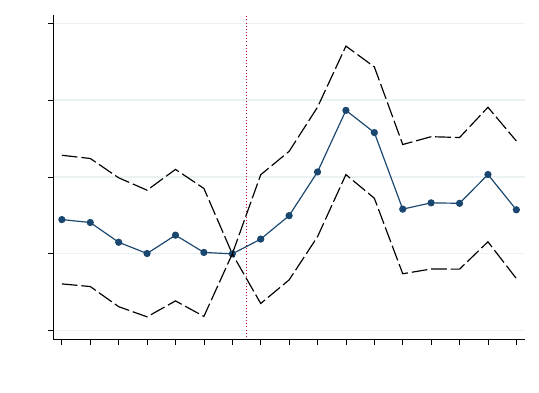
after the policy change. Estimates are presented in Figure A-2. Here it appears that
the treatment effect of communication stabilizes after five weeks.
Figure A-2: Week-Specific Effects—Extended Sample
−.005 0 .005 .01 .015
Estimated Effect on Success Rate
−6 −5 −4 −3 −2 −1 0 1 2 3 4 5 6 7 8 9 10
Week
Notes: This figure depicts week-specific effects using the differences-in-differences approach with the extended sample
which uses seven weeks before the change and ten after. The omitted coefficient (normalized to zero) is the week just
prior to the change.
2 Seller Fixed Effects
Next, we consider replicating the estimates from Table 3 with seller fixed effects. This
is meant to address a number of concerns. Most importantly, the category fixed effects
that we include in our main specification are rather coarse, and so seller-level fixed
effects might do a better job of controlling for product unobservables. In particular,
we are concerned that the composition of listings on which interactions are occurring
is different in unobservable ways for the treated group and the untreated group, which
might lead us to find spurious effects.
Estimates are presented in Table A-5. We have limited ourselves to replicating only
the models with the full set of controls. We see a slight attenuation of the estimates,
but the
ˆ
β
C
dd
and
ˆ
β
C
iv
remain statistically significant and statistically indistinguishable
from the estimates of Table 3.
Appendix-6

E Text Analysis Details
1 Message Examples
Table A-6 shows a curated set of examples messages sent with offers in our data.
Messages range from the simple declaration of an offer to signals of willingness-to-pay
or accept (e.g. “I do not go down”).
25
Some messages are meant to entice better offers,
such as offering bulk discounts. Some messages clarify aspects of the item (like missing
a hard drive). Still others seem like endearment and politeness, perhaps an attempt
to foster or appeal to other-regarding preferences. Therefore, messages seem to serve
a multitude of functions: cheap talk, signaling about buyer and seller characteristics,
resolving informational uncertainties about the product, endearment, and more.
2 Data Construction
The text analysis of Section 5 uses the dataset of 248,722 messages sent in the ten
weeks following May 25, 2016. This reflects some preliminary cleaning: messages
consisting only of numbers or spaces are excluded. Also, messages such as “please
enter your message here” (in a variety of languages), which we believe to be an artifact
of third-party software for sellers to create listings and upload them via the API, have
been manually detected and excluded.
Most of the analysis is conducted on the “processed” messaging dataset. The
processing of the messaging takes place in four steps.
1.
First, we use a Python implementation of Google’s language detection algorithm
to classify messages by language. After this, we keep only the messages that are
detected to be in German.
2. Second, we remove all numbers, symbols, and extra spaces from each message.
3.
Third, we remove stop words. This list of stop words comes from NLTK’s set
of German stop words. We remove “nicht” (“not”) from this list as this token
appears to be important in the context of bargaining.
4.
Next, we stem the messages. To do this we use the NLTK’s German Snowball
Stemmer.
25
“MFG” is a common acronym translating to “with regards.”
Appendix-7
3 Heat Maps and their Corresponding Figures
Figure A-3 shows our heat map results and off-diagonal plots for different cuts of
buyers based on the number of messages they sent throughout the ten week period
following the introduction of messaging on eBay Germany Best Offer. As expected,
these figures are filled with noise and present no obvious patterns. Figure A-4 depicts
the same figures, but for sellers. Here, we find that our results strengthen as we
restrict attention to experienced sellers. As a robustness check, Figure A-5 presents
the heat map figures and off-diagonal plots for buyers and sellers who only sent one
message during this time period. We find that sellers that send only one message have
no patterns in messaging content, which further suggests that seller learning is driving
our results among experienced sellers.
Figure A-6 includes the bottom gradient results for buyers and sellers without
being scaled by the cosine distance between week 9 and week 10 messages. As seen in
Panel (a), the cosine distance for buyer messages is close to being orthogonal (near
one) for the group of buyers that sent six or more and five or more messages. One
reason we are getting this result is because we have few buyers who’ve sent multiple
messages, for instance, only 496 buyers sent five or more messages. This highlights
one weakness of our cosine distance measure, namely that it’s sensitive to the number
of messages in each sample.
As a robustness check, Figure A-7 then includes the number of messages by group
for buyers and sellers across weeks. We also include these figures scaled by the number
of messages in week 10. In this figure, there is some noise in the number of messages
by week, however, we don’t see a significant rise in the number of messages sent by the
set of sellers with multiple messages in later weeks—such a rise would cause concern
for our main results in Section 5.3.
F An Exploration into Seller Messages
In Section 4, we presented results that suggest that sellers are learning across our
ten-week sample period; furthermore, we found that this result is driven by experienced
sellers. In this section, we implement a distributed multinomial regression model
(DMR) from Taddy (2015) that explores the relationship between seller experience
and the bigrams sent by sellers in our messaging dataset.
Appendix-8
1 Data Reduction
For this analysis, we are using the same dataset as the one discussed in Section 5.1.
Similar to Section 5.2, we construct a matrix
C
s
consisting of seller bigram counts;
recall that element
c
s,mj
of
C
s
corresponds to the number of counts for bigram
j
in
message
m
. Now, in order to lower the computational costs of running a regression
model, we went through of series of cleaning steps. These steps were aimed at reducing
some of the high dimensionality of our messaging dataset without loss of significant
information—as mentioned, we have more than 280,000 bigrams in our original sample
of seller messages.
The processing steps are as follows: 1) we remove bigrams that contain less than 5
characters, 2) we remove bigrams where one of the tokens in the bigram contain only
1 character, 3) we drop all sellers that sent more than 21 messages, 4) we remove all
bigrams that are used less than 10 times across seller messages, 5) we drop bigrams
that are said by only one seller, and 6) we remove the empty rows that the previous
two steps created in matrix C
s
.
For step 3, we drop sellers that are sending more than 21 messages as we expect that
these sellers might be very different than sellers sending between 1 and 20 messages;
for instance, these serial sellers are probably more likely to be active on different
sites and, as a result, they might already have had experience sending messages to
buyers prior to the introduction of messaging on eBay’s Germany Best Offer platform.
Second, as we are concerned about how sellers are changing messaging content from
one message to another, it makes sense for us to set bounds on the message number.
Dropping these sellers from our sample only removes 217 sellers out of our original
60
,
076. In total, these steps reduce the dimension of matrix
C
s
to be 86,879-by-8,069;
representing the 86,879 messages in our sample that contain 8,069 unique bigrams.
We construct our final dataset by then merging a number of controls to our matrix
of bigram counts. In addition to the controls documented in Section 3.2, we add
dummies for the total number of messages sent by that seller, a variable representing
the message length—which we measure by the number of tokens in the raw message—
and the log of the offer price attached to the message. We then have 242 controls
included in our analysis.
Appendix-9

2 The DMR Model
Our main variable of interest is the message number sent by that seller. Here, we
hope to further understand the bigrams that are correlated to seller experience. To do
this, we implement a distributed multinomial model from Taddy (2015). This model
was additionally used as the preferred specification in Gentzkow et al. (2019b); in
this paper, the authors analyze congressional speeches from 1873 to 2016 in order to
estimate the trends in partisanship.
In implementing this model, we are first assuming that our bigrams counts are
being generated by the multinomial distribution.
26
Specifically, the counts in each
message
m
are drawn by the multinomial distribution with parameters
n
m
=
P
j
c
mj
,
the total number of bigrams said in message
m
, and probability vector
p
m
, indicating
the probability of including each bigram conditional on the controls specified in the
previous section. To compute these probability vectors, we we would then estimate
p
mj
=
exp(ζ
mj
)
P
l=1
exp(ζ
ml
)
, where ζ
mj
= α
j
+ β
j
v
m
+ ρ
j
x
m
.
Here, the vector
v
m
represents our set of controls for message
m
; additionally, message
number, our proxy for experience, is denoted by x
m
.
Rather than running a computationally intensive multinomial logistic regression,
Taddy (2015) notes that we can instead assume
c
mj
∼ P ois
(
exp
[
µ
m
+
α
j
+
β
j
v
m
+
ρ
j
x
m
])
where we fix
µ
m
as
ˆµ
m
=
log
(
n
m
). This allows us to run separate Poisson regressions
for each bigram.
For each Poisson regression we then estimate the coefficient on message number
for bigram j by minimizing
X
m
[n
m
exp(ζ
mj
) − c
mj
(ζ
mj
)] + λ[
1
τ
X
k
|β
jk
| + |ρ
j
|].
27
In this equation, we include L1 regularization through the penalizing term, λ, which
reduces the number of features in our model by shrinking the coefficients
β
j
and
26
This assumes that each bigram in a message is independently generated. While this assumption
is undoubtedly violated, assuming a multinomial distribution for text is common practice (see Taddy
(2015), Gentzkow et al. (2019a)).
27
Note that the coefficients for our controls and message number are standardized so that they
have a standard deviation of one.
Appendix-10

ρ
j
toward zero. For this exercise, we selected the
λ
that minimizes the mean out-
of-sample deviance using 10-fold cross-validation (CV).
28
We chose to incorporate
variable selection into our model in order to generate a more interpretable output and
to avoid over-fitting our data. Importantly, we suspect that there are many bigrams
in our dataset that have no or little relation to seller experience. This penalizing term
then introduces sparsity into our model and will shrink the coefficients for message
number to zero if they have little out-of-sample predictive power for those bigrams.
Next, we vary the level of
τ
. Setting
τ
= 0
.
1
,
0
.
5, 1
,
and 3 changes the extent of
the penalty the model imposes on the set of controls. A smaller
τ
means that we will
be incorporating a larger penalty on our controls rather than message number; while
a larger
τ
will reduce the collinearity between our controls and variable of interest as
we inflict a lower penalty on β
j
.
3 Experience Results
We present our results in three separate tables: First, Table A-7 includes the top and
bottom 10 bigrams determined by the coefficients on message number for different
levels of
τ
. Next, we generate an estimated experience score for each message. This
is simply the summation of the bigram coefficients generated by our model for each
message. We then present the top and bottom scoring messages in Tables A-8 and
A-9.
In all three tables, we blocked out any potentially identifying information. This
includes names, company names, addresses, and emails. We used Google Translate’s
API for the translations from German to English. In some of cases, we found that
using the web version of Google Translate produced a different result than the API; in
these cases, we used the translation from the web if we found that it presented a more
interpretable result. Finally, in Table A-7, note that these translations are generated
on the stemmed bigrams; this will slightly change the translation from the translation
of the words actually used in the message. See the next two tables for translations on
the raw messages themselves.
The second column of these tables indicates the number of nonzero coefficients for
message number. Here, we can see that as
τ
increases in size, our controls absorb a
28
We ran the same model using 5-fold CV and found similar results. Results can be shown upon
request.
Appendix-11
larger amount of the variation in
ρ
j
, effectively shrinking a growing number of these
coefficients to zero. Additionally, we should note that the top and bottom bigrams
and messages are fairly robust to the value we set for τ .
In Table A-7, within the top bigrams by message number, we see a lot of farewells
and message sign-offs. For instance, “mfg” means “best regards” in German and
is a common way to end communication in electronic messages—we see this in two
separate bigrams in our
τ
= 3 specification. Similarly, “lg” shows up for all values of
τ and is another common farewell in German.
In our list of the bottom 10 bigrams, we don’t see any farewells, but a few greetings
do appear: “greeting [NAME]” and “dear interested person”. The efficacy of greetings,
farewells, and gratitude in successful bargaining and negotiations is unclear from the
previous literature as some authors find that friendly communication will lead to
more trust and reciprocity in bargaining and, as a result, better outcomes (Hine et al.
(2009), Kopelman et al. (2006)); alternatively, others have found communicating in
firm, and potentially more aggressive, tones are good strategies in negotiations (Jeong
et al. (2019), Belkin et al. (2013)).
In Table A-8, the top scoring message for all versions besides
τ
= 3, displays one
interesting strategy that sellers may be adopting: Here, we see a seller justifying their
cost through explaining that there is a “10% ebay commission, shipping, etc.” In a
similar fashion, we also see sellers justifying charging a higher price in the auction due
to the “sales commission” and through the fact that the item is already discounted.
Alternatively, in Table A-9, sellers seem to be more often justifying the costs of
the item through either the price they paid for the item or by providing details on the
item: the “jacket [is] made of real leather,” the “book was purchased completely new,”
the wardrobe is “very beautiful.” Additionally, the sellers appear to be less assertive
in their messaging through their usage of “would be happy,” “I hope they can also
make friends with my proposal,” “if that’s okay.”
4 Message Success Robustness
In this section, we replicate our analysis from Section 6 for the full set of sellers and
for the set of sellers that sent fewer than 11 messages. Table A-10 presents the results
from regressing message success on the cosine similarity of each message and the set
of week 10 messages for our entire sample. Moreover, Table A-11 includes the same
Appendix-12
regression excluding sellers that sent 11 or more messages from the analysis. Our
results are somewhat weaker when including the full set of sellers. Moreover, our
coefficient on our similarity measure is negative and insignificant when including seller
fixed effects. The results restricting to sellers with fewer than 11 messages largely
align with our previous findings.
Appendix-13

Table A-2: Estimates for Alternative Outcome Variables
Full Sample Conditional on Agreement
(1) (2) (3) (4) (5) (6)
No. Offers ln(First Offer) ln(Agreed Price) Buyer Offer Seller Counter Buyer Counter
β
C
pp
-0.0047 0.0130
∗
0.0087
∗
0.0108 0.0086
∗
0.0123
∗
(0.0039) (0.0031) (0.0041) (0.0058) (0.0019) (0.0047)
β
C
dd
-0.0040 0.0011 -0.0047
∗
-0.0068 0.0011 -0.0005
(0.0028) (0.0015) (0.0024) (0.0035) (0.0012) (0.0027)
β
C
iv
-0.0743 0.0206 -0.0959
∗
-0.2690 0.0119 -0.0042
(0.0519) (0.0276) (0.0478) (0.1384) (0.0130) (0.0229)
Controls X X X X X X
N
pp
1770261 1770261 832365 518199 128659 38829
N
dd,iv
3294362 3294362 1454658 861031 218678 85038
Notes: This table presents estimates for alternative left-hand-side variables. Note that all estimates of β
C
pp
use the desktop sample only, and (3) is conditional on success.
Model (4) uses interactions in which a buyer’s initial offer was accepted by the seller; (5) uses interactions where the buyers offer was countered by the seller and the
buyer accepted the counter-offer, and finally (6) uses the set of interactions where the buyer made an offer, the seller countered, the buyer countered the counter, and the
seller accepted. Controls include a time trend; ln(ask price); category by condition fixed effects; day of week, precipitation, and holiday dummies and the temperature.
Heteroskedacticity-robust standard errors, clustered by seller, are reported in parentheses, and
∗
denotes statistical significance at α = 0.05.
Appendix-14

Table A-3: Estimates by Asking Price Range
(1) (2)
Ask Price in ($0,$50) 0.0945
∗
0.1044
∗
(0.0366) (0.0362)
Ask Price in [$50,$150) 0.0957
∗
0.0898
∗
(0.0354) (0.0351)
Ask Price in [$150,$250) 0.0387 0.0241
(0.0490) (0.0485)
Ask Price ≥ $250 0.0284 0.0351
(0.0321) (0.0318)
Controls X
Notes: This table presents estimates of β
C
iv
for four different price ranges. Note that price ranges are defined in USD.
All parameters of the model are estimated independently for each coefficient estimate. In model (1), no controls
are included, while in model (2), the full set of controls detailed in Table 3 are included. Heteroskedacticity-robust
standard errors, clustered by seller, are reported in parentheses, and
∗
denotes statistical significance at α = 0.05.
Table A-4: Estimates by Sample Window
(+/-2) (+/-3) (+/-4) (+/-5) (+/-6) (+10/-7)
β
C
pp
-0.0008 0.0026 0.0023 0.0042
∗
0.0036
∗
0.0016
(0.0030) (0.0022) (0.0019) (0.0018) (0.0017) (0.0016)
β
C
dd
0.0017 0.0025 0.0042
∗
0.0047
∗
0.0040
∗
0.0034
∗
(0.0017) (0.0014) (0.0012) (0.0011) (0.0010) (0.0009)
β
C
iv
0.0344 0.0476 0.0773
∗
0.0865
∗
0.0731
∗
0.0597
∗
(0.0337) (0.0265) (0.0226) (0.0204) (0.0190) (0.0165)
Controls X X X X X X
N 1649026 2432528 3294362 4091076 4924926 6766228
Notes: This table presents estimation results mirroring Table 3 varying the sample inclusion window. Each cell is
the result of an independent regression. Each row represents a different estimation strategy: respectively, pre-post,
differences-in-differences, and instrumental variables. Each column represents a different sample, where the column
header indicates the number of weeks before and the number of weeks after May 23, 2016. Heteroskedacticity-robust
standard errors, clustered by seller, are reported in parentheses, and
∗
denotes statistical significance at α = 0.05.
Appendix-15

Table A-5: Estimates with Seller Fixed Effects
(1) (2) (3) (4)
Desktop Mobile Differences IV
1(Post) 0.0024 0.0024 0.0008 0.0011
(0.0016) (0.0018) (0.0013) (0.0012)
1(Desktop) 0.0355
∗
0.0355
∗
(0.0008) (0.0008)
1(Post) · 1(Desktop) 0.0027
∗
(0.0011)
1(Message) 0.0561
∗
(0.0222)
Controls X X X X
Seller FE X X X X
N 1770261 1524101 3294362 3294362
Notes: This table replicates models with the full set of controls from Table 3, where we now also include seller fixed
effects. Models (1) and (2) are pre-post estimates for the desktop and mobile samples, respectively, while models (3)
and (4) are differences-in-differences and IV estimates, respectively. Standard errors are reported in parentheses, and
∗
denotes statistical significance at α = 0.05.
Appendix-16

Table A-6: Example messages
Censored Message Excerpts (from Google Translate)
This is unfortunately the best price we can offer you.
Hello, under it does not go unfortunately. MfG
Hello, would like to ask if you would sell the article also for 15, - Euro. LG S. [NAME]
I do not go down sry
Incl. Shipping.
Hello dear [PRODUCT]-interested. What would happen if we met in the middle? There are also
figures outside of the electric carousel. Is that OK? Friendly Greetings [NAME]
Hello that would be my last price
let’s meet in the middle?
This is definitely the minimum
And they have not sold the vest until today, beat them to 49.00 euros is a good price and they finally
have their rest. . . Greetings
I would pay 105 euros if the [PRODUCT] was bought not more than 6 months ago and the original
invoice with rest guarantee is available and included. To compare: New at Voelkner currently
119,04 with 2 years warranty! MfG
25 Euro since articles new & unused.
I intend not to issue any higher offer.
Since the hard disk is missing! it’s alright?
With the purchase of several [PRODUCT], you save more - you pay postage only once.
not less....
... rarely laughed so much!
VERY SIMPLY
Would be glad if you accept this proposal.
Unfortunately, more I can not afford mfg
I’ll buy the [PRODUCT]!
This is a super cheap price !!
Notes: Here we present a curated set of messages by both buyers and sellers, translated by Google Translate from
the original German. We have censored any potentially identifying information, in particular individual and product
names.
Appendix-17

Figure A-3: Heat Maps and Off-Diagonal Figures for Repeat Buyers
(a) 2+ Messages (b) 2+ Messages
(c) 3+ Messages (d) 3+ Messages
(e) 4+ Messages (f) 4+ Messages
Notes: This figure depicts heat map results and plots along the off-diagonals of those heat maps representing the
cosine distance of message bigrams across the ten weeks following May 25, 2016 for different subgroups of buyers.
Panels (a) and (b) shows the results for buyers that have sent two or more messages during our sample period, Panels
(b) and (c) shows the same results for buyers that sent more than 3 messages, Panel (d) and (e) display the results
for buyers that appear four or more times in our messaging dataset.
Appendix-18
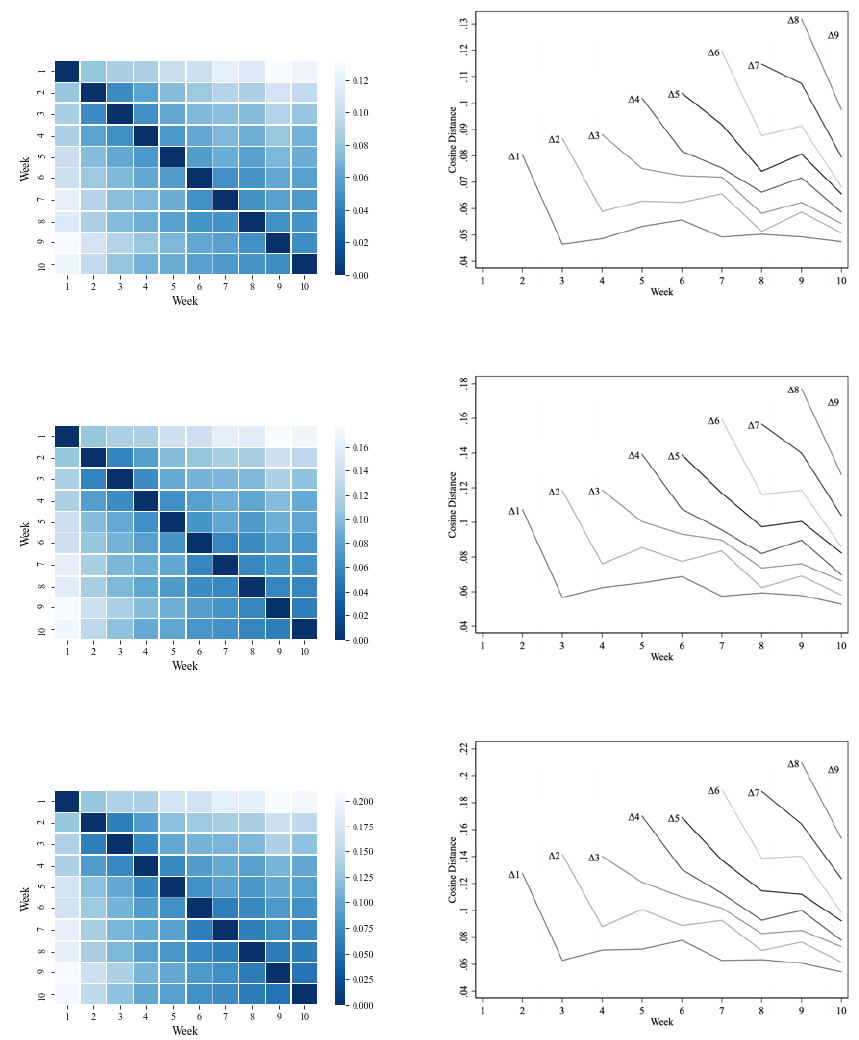
Figure A-4: Heat Maps and Off-Diagonal Figures for Repeat Sellers
(a) 2+ Messages (b) 2+ Messages
(c) 3+ Messages (d) 3+ Messages
(e) 4+ Messages (f) 4+ Messages
Notes: This figure depicts heat map results and plots along the off-diagonals of those heat maps representing the
cosine distance of message bigrams across the ten weeks following May 25, 2016 for different subgroups of sellers.
Panels (a) and (b) shows the results for sellers that have sent two or more messages during our sample period, Panels
(b) and (c) shows the same results for sellers that sent more than 3 messages, Panel (d) and (e) display the results
for sellers that appear four or more times in our messaging dataset.
Appendix-19
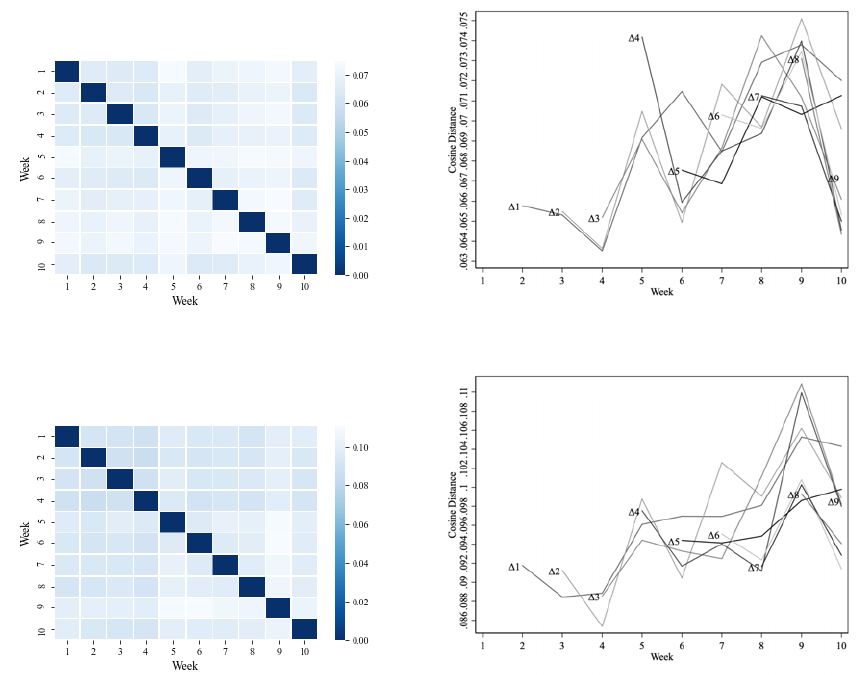
Figure A-5: Buyers and Sellers with No Experience
(a) Buyer Heat Map (b) Buyer Convergence
(c) Seller Heat Map (d) Seller Convergence
Notes: This figure depicts heat map results and plots along the off-diagonals of those heat maps representing the cosine
distance of message bigrams across the ten weeks following May 25, 2016 for buyers and sellers in our messaging dataset
that only sent one message. Panels (a) and (b) shows the results for buyers who sent one message within our sample
period and Panels (b) and (c) show the same results for sellers.
Appendix-20

Figure A-6: The Bottom Gradient for Buyers and Sellers with Different Experience
Levels
(a) Buyer (b) Seller
Notes: This figure presents the cosine distance between the messages sent in weeks x and 10 for buyers, Panel (a), and
sellers, Panel (b). Each panel is cut by groups, where All represents our results from buyer/seller messages for our
entire sample of buyers/sellers, 2+ from our sample of messages sent by buyers/sellers who sent 2 or more messages,
3+ from our sample of messages sent by buyers/sellers who sent 3 or more messages, and so on.
Appendix-21
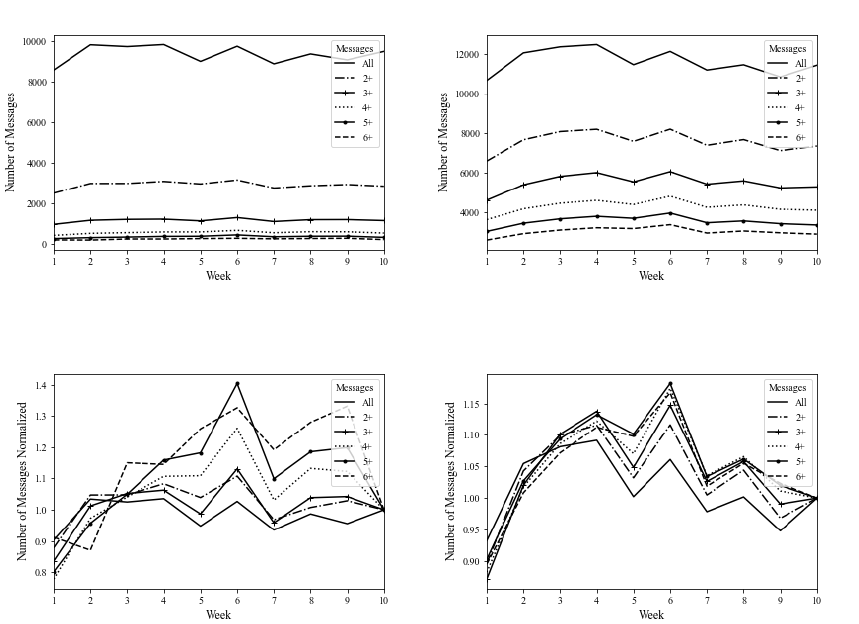
Figure A-7: Total Messages by Week for Buyers and Sellers
(a) Buyer (b) Seller
(c) Buyer Nomalized (d) Seller Normalized
Notes: This figure presents the total number of messages sent by buyers, Panel (a), and sellers, Panel (b), by week.
Panel (c) and Panel (d) are the buyer and seller number of messages scaled by the number of messages in week 10.
Each panel is cut by groups, where All represents our results from buyer/seller messages for our entire sample of
buyers/sellers, 2+ from our sample of messages sent by buyers/sellers who sent 2 or more messages, 3+ from our
sample of messages sent by buyers/sellers who sent 3 or more messages, and so on.
Appendix-22

Table A-7: Top and Bottom Bigrams Correlated with Message Number
τ Nonzero Bigrams
Top 10
3 152
thanks in advance mfg; award-understand; understand beg; without eba; low
number of pieces; pray thanks; discount safeguarded; lg [NAME]; mfg sale; known
does
dank vorausmfg; preis versteh; versteh bitt; ohn eba; gering stuckzahl; bitt dank; rabatt
gewahrt; lg [NAME]; mfg verkauf; kund tut
1 1730
so far; thanks in advance mfg; beg functional scope of supply; observe scope
of delivery; Regular price insof; lg [NAME]; down selling price; shipping cost
adjusted; award-understand; low number of pieces
insof schon; dank vorausmfg; bitt funktionslieferumfang; funktionslieferumfang beacht;
verkaufspreis insof; lg [NAME]; runt verkaufspreis; versandkost angepasst; preis versteh; ger-
ing stuckzahl
0.5 3603
beg functional scope of supply; observe scope of delivery; Regular price insof;
thanks in advance mfg; so far; down selling price; lg [NAME]; award-understand;
shipping cost adjusted; discount safeguarded
bitt funktionslieferumfang; funktionslieferumfang beacht; verkaufspreis insof; dank vo-
rausmfg; insof schon; runt verkaufspreis; lg [NAME]; preis versteh; versandkost angepasst;
rabatt gewahrt
0.1 6290
Regular price insof; beg functional scope of supply; so far; observe scope of
delivery; lg [NAME]; shipping cost adjusted; down selling price; rather tight;
Newly listed; sale mfgruss
verkaufspreis insof; bitt funktionslieferumfang; insof schon; funktionslieferumfang beacht; lg
[NAME]; versandkost angepasst; runt verkaufspreis; recht knapp; neu eingestellt; verkauf
mfgruss
Bottom 10
3 152
counter already; gb memory card; miss it not; from august; for figure; sale
however; greeting [NAME]; over-looking payment method; ready priced; far kart
entgeg schon; gb speicherkart; verpass nicht; ab august; fur figur; verkauf jedoch; gruss
[NAME]; uberweis zahlungsmethod; bereit preislich; weit kart
1 1730
counter already; is set; gb memory card; ready priced; greeting [NAME]; just
give; extremely fair; suggest price proposal; not worn; month old
entgeg schon; eingestellt wurd; gb speicherkart; bereit preislich; gruss [NAME]; geb einfach;
ausserst fair; preisvorschlag ordnung; nicht getrag; monat alt
0.5 3603
woman has; is set; counter already; day would like; interess shipping; cm wide;
extremely fair; natural possible; ready priced; just give
freu schon; eingestellt wurd; entgeg schon; tag mocht; interess versand; cm breit; ausserst
fair; natur moglich; bereit preislich; geb einfach
0.1 6290
woman has; cm wide; day would like; under asking price; new mature; extremely
fair; dear interested person; is set; brand new unworn; rims tires
freu schon; cm breit; tag mocht; unt preisvorstell; neu reif; ausserst fair; lieb interessentin;
eingestellt wurd; nagelneu ungetrag; felg reif
Notes: This table includes the top and bottom ten bigrams in both English and the original German ranked by our
coefficients on message number for different levels of τ . The second column in the table indicates the amount of
message number coefficients that are not penalized to zero for that value of τ .
Appendix-23

Table A-8: Top Messages
τ Nonzero Top Messages
3
152 1. this is our lowest price, please understand, many thanks in advance ... mfg (60)
dies ist unser niedrigster preis, verstehen sie bitte, vielen dank im voraus...mfg
2. hello, this product we played 20 % discount, and the price is already miss you please understand,
many thanks in advance ... mfg (20)
hallo, dieses produkt haben wir 20% rabatt gespielt, und der preis ist bereits mit verlust verstehen sie bitte, vielen
dank im voraus...mfg
3. they have slight problems when assessing the price but I understand that! (380)
sie haben leichte probleme beim einsch¨atzen des preises aber ich verstehe das!
1 1730
1. thank you for your price suggestion, but unfortunately it is below my purchase price: 10% ebay
commission, shipping, etc. are still going down and the selling price is calculated quite tightly.
please also note the scope of functions / scope of delivery! kind regards (40)
danke f¨ur ihren preisvorschlag, liegt aber leider unter meinem einkaufspreis: 10% ebay-provision, versand usw.
gehen ja auch noch runter und der verkaufspreis ist insofern schon recht knapp kalkuliert. bitte auch funktions-
/lieferumfang beachten! mfg
2. this is our lowest price, please understand, many thanks in advance ... mfg (60)
dies ist unser niedrigster preis, verstehen sie bitte, vielen dank im voraus...mfg
3. hello, this product we played 20 % discount, and the price is already miss you please understand,
many thanks in advance ... mfg (20)
hallo, dieses produkt haben wir 20% rabatt gespielt, und der preis ist bereits mit verlust verstehen sie bitte, vielen
dank im voraus...mfg
0.5 3603
1. thank you for your price suggestion, but unfortunately it is below my purchase price: 10% ebay
commission, shipping, etc. are still going down and the selling price is calculated quite tightly.
please also note the scope of functions / scope of delivery! kind regards (40)
danke f¨ur ihren preisvorschlag, liegt aber leider unter meinem einkaufspreis: 10% ebay-provision, versand usw.
gehen ja auch noch runter und der verkaufspreis ist insofern schon recht knapp kalkuliert. bitte auch funktions-
/lieferumfang beachten! mfg
2. this is our lowest price, please understand, many thanks in advance ... mfg (60)
dies ist unser niedrigster preis, verstehen sie bitte, vielen dank im voraus...mfg
3. hello, this product we played 20 % discount, and the price is already miss you please understand,
many thanks in advance ... mfg (20)
hallo, dieses produkt haben wir 20% rabatt gespielt, und der preis ist bereits mit verlust verstehen sie bitte, vielen
dank im voraus...mfg
0.1 6290
1. thank you for your price suggestion, but unfortunately it is below my purchase price: 10% ebay
commission, shipping, etc. are still going down and the selling price is calculated quite tightly.
please also note the scope of functions / scope of delivery! kind regards (40)
danke f¨ur ihren preisvorschlag, liegt aber leider unter meinem einkaufspreis: 10% ebay-provision, versand usw.
gehen ja auch noch runter und der verkaufspreis ist insofern schon recht knapp kalkuliert. bitte auch funktions-
/lieferumfang beachten! mfg
2. to get big discount, please send inquiry to delivery address directly to our e-mail. thank you
and friendly greetings, [NAME] [NAME] [company] [address] celle phone: xxxxx xxxxxxx email:
um großer rabatt zu bekommen, bitte senden sie anfrage mit lieferadresse direkt auf unsere e-mail. danke und
freundliche gr¨uße, [NAME] [NAME] [company] [address] celle telefon: xxxxx-xxxxxxx email: [email protected]
3. hello, thank you very much for your interest! I can offer you the lock for 80+ postage if we do
not go to the auction. I pass the sales commission on to you. just send me a message! best regards
(90)
hallo, vielen dank f¨ur ihr interesse! ich kann ihnen das schloß f¨ur 80 + porto anbieten, wenn wir auf die auktion
verzichten. die gesparte verkaufsprovision gebe ich so an sie weiter. senden sie mir hierzu einfach eine nachricht!
beste gr¨uße
Notes: This table presents the top three messages based on the summation of the coefficients on message number for
each bigram in the message for different levels of τ . The second column in the table indicates the amount of message
number coefficients that are not penalized to zero. We include the listing price in euros rounded to the nearest tens
place in parenthesis next to each message. Finally, the German version of the message is included below each English
translation.
Appendix-24

Table A-9: Bottom Messages
τ Nonzero Bottom Messages
3 152
1. good morning, thank you for your best offer. like I get to meet them on my original award, 50 I
can still give so. so we would be able to meet in the middle us virtually. with the request for your
understanding! m (400)
guten morgen, herzlichen dank f¨ur ihren preisvorschlag. gerne komme ich ihnen auf meinen urspr¨unglichen preis
entgegen, 50 kann ich schon noch nachgeben. so w¨urden wir uns quasi in der mitte treffen k¨onnen. mit der bitte
um verst¨andnis! m
2. I just discovered a very small hole on the back, so the price is a little bit more accommodating
.... best regards! (20)
auf der r¨uckseite habe ich gerade ein ganz kleines l¨ochlein entdeckt, daher komme ich im preis etwas entgegen ... .
sch¨onen gruß!
3. good day, many thanks for your interest in the wardrobe stand of classicon. it is a very beautiful
piece of furniture in excellent condition. like I get to meet them in the award. beautiful greetings to
jump! (1350)
guten tag, vielen dank f¨ur ihr interesse an dem garderobenst¨ander von classicon. es handelt sich um ein sehr sch¨onen
m¨obelst¨uck in hervorragendem zustand. gerne komme ich ihnen im preis entgegen. sch¨one gr¨uße nach springe!
1 1730
1. love potential customer, I like to go even at 55 down, but since that is not further jacket made
of real leather and as well as not being worn. I ask for understanding and would be happy about
their purchase still very! nice greetings, [NAME] [NAME] (60)
liebe interessentin, ich gehe gerne noch auf 55 runter, weiter jedoch nicht, da die jacke aus echtleder und so gut wie
nicht getragen ist. ich bitte um verst¨andnis und w¨urde mich ¨uber ihren kauf trotzdem sehr freuen! sch¨one gr¨uße,
[NAME] [NAME]
2. Suggest Price is ok, but please note notebook holidays. Shipping only possible again from 19:08.
if that’s okay, please buy. (10)
preisvorschlag ist in ordnung, bitte aber urlaubsnotiz beachten. versand erst wieder ab dem 19.08 m¨oglich. wenn
das okay ist, bitte kaufen.
3. since the book was purchased completely new and is not available in the book trade, I ask for
understanding that I no longer priced under these above-mentioned Suggest Price can go. I hope
they can also make friends with my proposal against. (10)
da das buch v¨ollig neu gekauft wurde und im buchhandel nicht erh¨altlich ist, bitte ich um verst¨andnis, das ich preislich
nicht mehr unter diesen o.g. preisvorschlag gehen kann. ich hoffe, sie k¨onnen sich mit meinem gegenvorschlag auch
anfreunden.
0.5 3603
1. love potential customer, I like to go even at 55 down, but since that is not further jacket made
of real leather and as well as not being worn. I ask for understanding and would be happy about
their purchase still very! nice greetings, [NAME] [NAME] (60)
liebe interessentin, ich gehe gerne noch auf 55 runter, weiter jedoch nicht, da die jacke aus echtleder und so gut wie
nicht getragen ist. ich bitte um verst¨andnis und w¨urde mich ¨uber ihren kauf trotzdem sehr freuen! sch¨one gr¨uße,
[NAME] [NAME]
2. I myself had EUR 80.00 plus shipping paid now for it: shipping included insured EUR 70.00. I
would be happy if the beautiful part is in good hands! kind regards! (80)
ich selbst hatte euro 80,00 plus versand bezahlt, f¨ur sie nun: euro 70,00 inklusive versicherter versand. ich w¨urde
mich freuen, wenn das sch¨one teil in gute h¨ande kommt! herzliche gr¨uße!
3. since the book was purchased completely new and is not available in the book trade, I ask for
understanding that I no longer priced under these above-mentioned Suggest Price can go. I hope
they can also make friends with my proposal against. (10)
da das buch v¨ollig neu gekauft wurde und im buchhandel nicht erh¨altlich ist, bitte ich um verst¨andnis, das ich preislich
nicht mehr unter diesen o.g. preisvorschlag gehen kann. ich hoffe, sie k¨onnen sich mit meinem gegenvorschlag auch
anfreunden.
0.1 6290
1. love potential customer, I like to go even at 55 down, but since that is not further jacket made
of real leather and as well as not being worn. I ask for understanding and would be happy about
their purchase still very! nice greetings, [NAME] [NAME] (60)
liebe interessentin, ich gehe gerne noch auf 55 runter, weiter jedoch nicht, da die jacke aus echtleder und so gut wie
nicht getragen ist. ich bitte um verst¨andnis und w¨urde mich ¨uber ihren kauf trotzdem sehr freuen! sch¨one gr¨uße,
[NAME] [NAME]
2. I myself had EUR 80.00 plus shipping paid now for it: shipping included insured EUR 70.00. I
would be happy if the beautiful part is in good hands! kind regards! (80)
ich selbst hatte euro 80,00 plus versand bezahlt, f¨ur sie nun: euro 70,00 inklusive versicherter versand. ich w¨urde
mich freuen, wenn das sch¨one teil in gute h¨ande kommt! herzliche gr¨uße!
3. sorry, but there is my lowest painful limit because the shoes have well over EUR 150 cost. I
would be happy if the beautiful shoes treat anyway. me they are unfortunately too small. (60)
sorry, aber da ist meine unterste schmerzgrenze, da die schuhe weit ¨uber eur 150 gekostet haben. w¨urde mich freuen,
wenn sie sich die sch¨onen schuhe trotzdem g¨onnen. mir sind sie leider zu klein.
Notes: This table presents the bottom three messages based on the summation of the coefficients on message number
for each bigram in the message for different levels of τ . The second column in the table indicates the amount of
message number coefficients that are not penalized to zero. We include the listing price in euros rounded to the
nearest tens place in parenthesis next to each message. Finally, the German version of the message is included below
each English translation.
Appendix-25

Table A-10: Message Success (All Sellers)
(1) (2) (3)
Sim(m, week 10) 0.0456
∗
0.0345
∗
-0.0277
(0.0168) (0.0170) (0.0352)
Message Length 0.0009
∗
0.0002
(0.0002) (0.0004)
N 113600 113600 73839
Controls X X X
Seller FE X
Notes: This table presents our results from regressing message success onto a measure of seller experience. Sim(m,
week 10) is the cosine similarity between a message and the set of week 10 messages. All models include our main set
of controls: time trend; ln(ask price); category by condition fixed effects; day of week, precipitation, holiday dummies,
and the temperature. Model (3) includes seller fixed effects. Robust standard errors are reported in parentheses and
∗
denotes statistical significance at α = 0.05.
Table A-11: Message Success (Sellers with Fewer than 11 Messages)
(1) (2) (3)
Sim(m, week 10) 0.0589
∗
0.0485
∗
0.0671
(0.0235) (0.0236) (0.0457)
Message Length 0.0014
∗
0.0003
(0.0002) (0.0005)
N 95617 95617 55903
Controls X X X
Seller FE X
Notes: This table presents our results from regressing message success onto a measure of seller experience. Sim(m,
week 10) is the cosine similarity between a message and the set of week 10 messages excluding sellers who sent more
than 11 messages. All models include our main set of controls: time trend; ln(ask price); category by condition fixed
effects; day of week, precipitation, holiday dummies, and the temperature. Likewise, all models drop sellers sending
more than 10 messages. Model (3) includes seller fixed effects. Robust standard errors are reported in parentheses
and
∗
denotes statistical significance at α = 0.05.
Appendix-26
